Island wind power succeeded on cost
But challenges remain as turbines age
BY SUSAN MUSTAPICH
Fifteen years after its spinning blades began generating electricity, the Fox Island Wind project succeeded in saving islanders money. In fact, customers on the islands it serves—Vinalhaven and North Haven—have paid less for electricity than their mainland counterparts in the first decade of operation.
But challenges loom, including the aging of the turbines, which will force a vote in the near future on either repowering or decommissioning wind energy generation.
The 1.5-megawatt-producing turbines have achieved laudable climate goals, the staff of the nonprofit Fox Islands Electric Cooperative report, offsetting the release of 36,600 tons of carbon dioxide into the atmosphere.
The turbines are owned by the cooperative, its subsidiary Fox Islands Wind, and the resident customers of Vinalhaven and North Haven. Fox Island Electric now owns the property where the wind turbines stand and leases the land to Fox Islands Wind.
The power company hired Amy Turner, an attorney and previous general counsel for a large electric cooperative in Colorado, as CEO in 2020. In the face
READY TO HAUL—

of change, the cooperative is seeking input and maintaining transparency, she said.
“The directors of Fox Islands Electric and Fox Islands Wind have been hosting community meetings to discuss the challenges and options of creating, operating, and maintaining a modern electric grid that meets our community’s vision,” Turner said. Past
Ferry service proposes higher fares
Inflation cited for revisiting 2019 fare hike
BY TOM GROENING
The Maine State Ferry Service is proposing a 18.3% hike in ferry passenger and vehicle fares, citing inflation’s impact on wages, fuel, and vessel repairs.
A fare hike was adopted in 2019, finalized only after significant opposition from residents of some the islands that faced especially high fare adjustments. The final rates were amended and won acceptance from most island communities.
meetings can be viewed on the FoxIslandsWind.com website, where future meetings are also announced.
The meetings are also preparation for a decision on the future of the wind turbines. At close to 15-years-old, they are nearing their 20-year life span. Turner is focusing on providing residents with
continued on page 4
The state ferry service, part of the Department of Transportation, serves Frenchboro, Swan’s Island, Islesboro, North Haven, Vinalhaven, and Matinicus.
The new rate proposal, or tariff, continues a tradition of higher rates during the summer months. It also shifts some of the burden of the hike onto trucks.
By law, the ferry service is supposed to be funded in a 50/50 split between the state highway fund and fares and fees. In some recent years, the highway fund has borne more than that 50%, which has prompted changes, including eliminating the discount for tickets purchased on islands.
tariff was held at the Samoset resort in Rockport on March 12. Ferry service director Bill Geary, a Vinalhaven native who now lives in Rockland and who studied at Maine Maritime Academy and served in the Navy, opened the hearing by outlining his emphasis.
Geary cited higher costs for diesel fuel, parts, supplies, contractors, and staff.
DOT pays all of the cost of new boats and port improvements.
“My top priority since coming on has been to build a strong collaborative relationship with all the communities we serve,” he said.
“Since 2019, Maine DOT has spent over $79 million in state and federal funds on the Maine State Ferry system,” including operational and capital costs like new vessels. “No increase is easy, but as I’m sure you’re all aware, the cost of just about everything has gone up.”
Geary cited higher costs for diesel fuel, parts, supplies, contractors, and staff.
A public hearing at which public comment was sought on the proposed continued on page 4
NON-PROFIT ORG. U.S. POSTAGE PAID PORTLAND, ME 04101 PERMIT NO. 454 News from Maine’s Island and Coastal Communities published by island institute n workingwaterfront . com published by island institute n workingwaterfront . com volume 38, no. 3 n may 2024 n free circulation: 50,000 CAR-RT SORT POSTAL CUSTOMER
Despite the wild swings in Maine coastal weather in recent weeks, the lobster fishery will be on the water setting traps before too long. In Jonesport, Dirk Sawyer, who has been fishing since he was ten, was readying his boat and fishing gear at the public landing. PHOTO: JACK SULLIVAN
Despite legal restrictions, rockweed business thrives
Ocean Organics in Waldoboro sells to golf courses, farms
BY TOM GROENING
Seaweed has been used as a soil amendment for as long as crops have been grown, with documented use dating to the Roman Empire. In Maine, it was used by indigenous people, and then during the colonial period, hauled in wagons from the shore.
It remains in use today, and the enriching elements of Maine rockweed are nourishing golf courses and potato fields as far away as California, thanks to Ocean Organics, a company based in Waldoboro’s business park.
The company’s vice-president George Seaver is a passionate advocate for the industry, and he worries the supply of rockweed—harvested from the intertidal zone—may be threatened by recent court rulings, which he calls “troubling.”
That concern is well-founded, given the landmark ruling by the state’s supreme court in Ross vs. Acadian Seaplants, which found that rockweed growing between the low tide and high tide lines was owned by the “upland” landowner. That landowner could deny harvesters access to the plant, even if the cutting was done from a boat.
For now, Seaver’s business is getting the rockweed it needs. And the 4-foot-cubes sitting in the parking lot, bound for customers across the country and Canada, attest to the demand for the product.
Seaver moved to Maine from Connecticut in 1977, inspired by a story in Down East magazine about early seaweed entrepreneur Bob Morse.
“That’s what kind of got me up here,” he said during a conversation in the office adjacent to the company’s plant. Seaver worked for Morse from 1977 to 1991. The business, Atlantic Laboratories, dries seaweed and makes liquid extracts, among other uses. Though rockweed has been sustainably harvested in Maine for a long time— Seaver says it was cut in Boothbay Harbor in the 1860s, used to fertilize tobacco fields in Connecticut—there is opposition to the practice today.
“We are viewed by conservation groups as evil industrialists who are going to ruin the shore,” he says. “We’re kind of the good guys, but we’re
perceived as not,” he says, arguing that over-harvesting or cutting the rockweed—which, as its name implies, attaches itself to rock—too severely would be bad business.
“It’s completely counter-productive to have a short view of the resource,” he says.
Most rockweed in Maine is harvested in the Downeast part of the state where tidal ranges are greatest, though the plant can be found as far south as Rhode Island.
Ocean Organics was born from Atlantic Laboratories, also located at the Waldoboro site. “We compete a little bit, but not as much as you would think,” Seaver says. Between the two businesses, more rockweed is processed here than anywhere else in the state.
A customer in Michigan purchasing from Atlantic Laboratories wanted a dedicated source to provide its product, and so Ocean Organics was established. Since then, the business has developed other customers.
“It’s sort of a niche,” he says. “We’re shipping products all over the world.”
Seaver is careful about sharing competitive specifics but explains the product is a sort of tea made from the rockweed with other substances added. The business purchases “several hundred tons a year” of rockweed, harvested by independent contractors from a couple locations on the coast.
The product is delivered to customers in 4-foot square totes, hauled on tractor-trailer trucks, and sold in 2.5-gallon containers, often as a “private label,” meaning the individual customer then mixes in additives tailored to the use. One common use of the product is to fertilize golf courses, though Seaver reports that potato fields have seen 5% to 15% increases in yield when the product is applied.
“A lot of it gets on potatoes,” he said. When the economy crashed in 2009, the company pivoted from golf courses to agricultural customers. Export markets in South Korea, Japan, and China are being developed.
“We spend well over $100,000 a year on research,” he says, working with Cornell, Rutgers, Virginia Tech, and others.
A dried product made from the residue of the liquid-making process is also sold. “We make some really good,
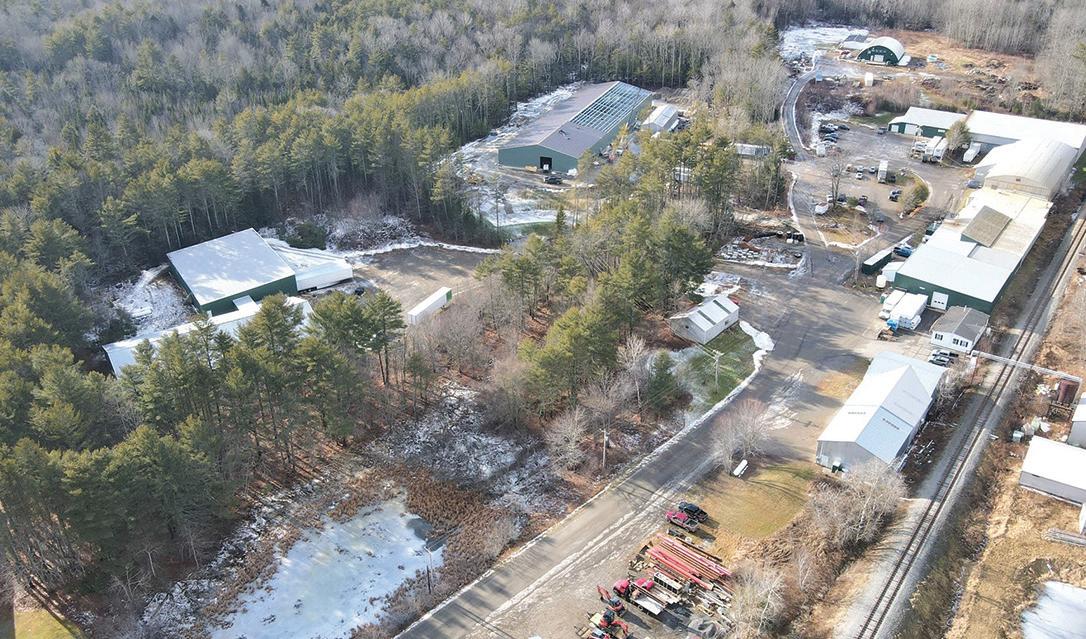
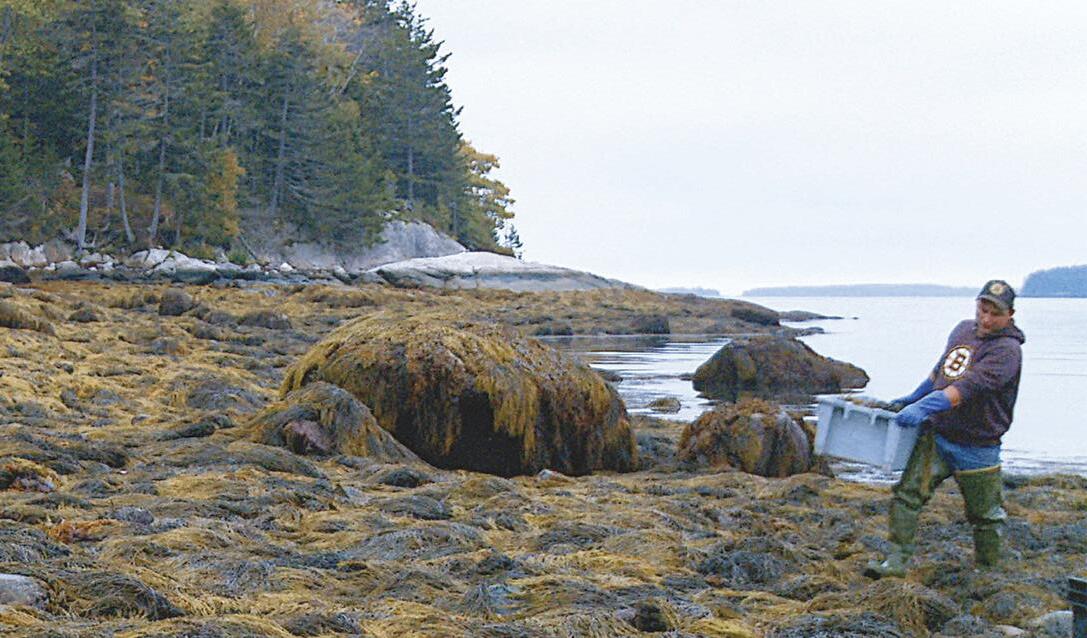
granulated fertilizers used on some of the best golf courses in the country.”
But will this business, which employs about two dozen at the Waldoboro plant, remain as constant as the resource it extracts? Seaver worries courts may be out of their depth when it comes to ruling on matters intertidal.
At the root of the legal wrangling is a nearly 400-year-old piece of legislation that still holds sway. The Colonial Ordinance of 1647 stipulates that access to the intertidal zone is permitted for three general purposes: fishing, fowling, and navigation. The state defines harvesting seaweed as fishing, Seaver says, and he believes the court’s ruling is in conflict with current Maine law.
But Seaver argues that the ordinance’s language was about proprietors, who were allowed to build docks, and suggests that it gave control of the intertidal zone to shorefront business owners, not ownership of the property in the intertidal zone.
If shorefront landowners do indeed control the intertidal zone, he argues they should confirm ownership through title searches, be taxed on that property, and be responsible for marking it.
Environmentalists argue that harvesting is harmful to the habitat rockweed creates. Seaver counters that harvesters must leave 16 inches of plant, and that mechanical devices are designed to avoid overharvesting. One analogy is that it’s like cutting fir


boughs to make wreaths—the plant survives and thrives from the pruning.
Despite what seems to be a trend toward restricting harvesting, Ocean Organics is thriving. Seaver gives a tour of an unused industrial building across the street in which the operation will expand.

2 The Working Waterfront may 2024
Seaweed harvesting.
The fertilizer product made from rockweed.
The fertilizer product in totes, ready to be shipped.
George Seaver.
An aerial view of the business park.
Women of the waterfront
Three harbormasters describe juggling competing interests
BY DORATHY MARTEL
Facilities manager. Juggler. Mediator. First responder. Diplomat. Code enforcer. These are some of the roles harbormasters fill, as revealed during a panel discussion hosted by Midcoast Women on March 13 at Rockport Public Library.
Kathy Given has been Belfast’s harbormaster for 30 years. She’s not sure whether she was Maine’s first female harbormaster, but she remembers that she was the only woman with that job title in the state when she started in 1994.
When she first moved to Maine in 1982, Given said, “Belfast was not really a place where most people wanted to go.” Now the city is a destination for mariners, who can “walk off the boat and provision, get dinner, go to a movie.”
Like Givens, Rockport Harbormaster Abbie Leonard prioritizes harbor access for a wide range of people. She described her office as a fishbowl from which she juggles the needs and wants of many “strange bedfellows”— fishermen, taxpayers, transient boat owners, children.
Rockport finds ways to bring people together at the harbor, she said, through activities such as concerts and New Year’s Eve fireworks displays. The result, she said, is like a Norman Rockwell painting and “so much of what Maine should be.”
“Just because there’s no boats in the water [in winter] doesn’t mean the job is done.”
—ABBIE LEONARD
Givens said she has “always been a big proponent of diversity,” naming fishermen, rowers, kayakers, and school science programs as some of the various users of the harbor and its facilities.
However, balancing the competing needs of constituencies is key. For instance, she explained, “You can put a T-shirt shop anywhere, but you can’t put a fisherman anywhere.”
Leonard didn’t always aspire to be a harbormaster: She wanted to play for the Red Sox. That didn’t happen, and she managed marinas instead. Then, 16 years ago, her father told her that if she didn’t turn in her resume for the position of Rockport harbormaster, he’d bring it to the town office for her. She was hired and has held the job ever since.
Harbormaster is a year-round job, Leonard said.
“Just because there’s no boats in the water [in winter] doesn’t mean the job is done.” Maintenance—and finding ways to fund it—is a concern regardless of the season.
The Federal Emergency Management Agency (FEMA) funds some of the repairs needed due to storm damage, but working with them “is a nightmare,”
she said. “They want to spend a dollar to save a dime.”
FEMA funds projects that return damaged infrastructure to pre-storm condition, which doesn’t solve the problem, since pre-storm fixes don’t take climate change into account. For example, water has “come over” six times in her career, Leonard said—and half of those events occurred since Jan. 1 of this year.
Molly Eddy, a year and a half into her time as Rockland’s harbormaster, described herself as the “baby” of the three panelists. She applied to be assistant harbormaster “as a joke.” She got the position, her boss resigned six weeks later, and she has been in charge ever since.
Eddy, too, mentioned access, conflict resolution, and responding to storm damage as important parts of the job. Rockland, she said, has received funding to raise the middle pier, where the food trucks are, and also plans to raise Harbor Park at some point.
Making these changes requires an openness to diverse points of view. People will talk about sea level rise, she said, “if you take the buzzwords out. People working on the waterfront know about it in the way people sitting in their living rooms don’t.”
Given noted that Belfast, too, is working on a hazard mitigation plan.
“To have five substantial storms in a year and a half really wakes you up,” she said.
Climate is impacting property insurance Eastern Washington County seeing higher premiums
BY LORA WHELAN
Coastal property owners may be in for a surprise when their home insurance is up for renewal. Damages to homes from this winter’s high winds, storm surges, and driving rain has meant higher premiums and canceled policies in some zip codes.
Roger Quirk of Lubec learned that one company no longer insures any real estate in his zip code.
“I didn’t realize insurance companies could say ‘no,’” he said. Quirk eventually found property insurance with a regional agency with knowledge of where his property is located and the risks, or lack of, from increasingly challenging weather.
Climate change is having an impact on properties in zones now considered risky but also on properties that aren’t at risk, explains Paul McKee, president of the Maine Association of Realtors. Flood zone maps are being updated for Washington County later this year, he notes.
“That will certainly have an impact,” he says. “A lot of [coastal] properties
will now be in flood zones. We’re seeing more flooding, dangerous winds, and houses having been built close to the ocean seeing increased damage and increased claims.”
Even properties not near flood zones are being affected by the change in insurance policies. McKee describes a real estate transaction he is working on in southern Maine. The property is on a high hill and in no danger of any flooding but like many older Maine houses, its basement is damp. The mortgage underwriter then wanted to research whether the dampness was a threat to the building. What once was common for old homes in New England is now a possible obstacle to securing a mortgage and insurance.
Eastport’s historic Hobbs house, located in the middle of the city’s residential area and well above the flood zone, has not been without its own insurance hiccups. Owner James Pollowitz has been renovating and restoring the Federal era house and used Lloyd’s of London during the construction phase. Once the construction phase was complete it was difficult to find an insurer.



“I tried eight or nine insurance companies, all leads from neighbors,” he says. Agents “were sticklers for lead and peeling paint. I’m finding that most companies have no interest in historic homes,” particularly when they are secondary homes, as is the case with the Hobbs house.
“The whole market is completely changing because of climate change. Winds are a huge factor,” says Pollowitz. “They’re getting huge numbers of claims on houses that probably shouldn’t have been built where they are.”
Compounded by the larger national insurance issues of fire, hurricanes, and tornadoes that are influencing insurance company decisions, Washington County’s demographics don’t help, he adds. The insurance company’s replacement cost for the Hobbs house would be in the millions, a price tag that isn’t realistic for the area. “That tipped the scale to be excluded” from being insured. He finally found a local agent “who was wonderful and very supportive.” The trend is for insurance companies to divest of coastal properties, Pollowitz was told.
Property buyers and sellers need to be aware of the changing insurance market, says McKee.
“We are seeing more and more challenges,” he notes, “even in properties that aren’t close to flood zones.” Those changes are happening almost weekly, he adds.
Prospective real estate buyers “need to research insurance at the beginning of the due diligence phase, not at closing. You better get it then, because you need to be able to get out of the contract if you can’t get insurance or the premiums are too high.”
McKee recommends property owners and buyers regularly check the Federal Emergency Management Agency flood zone maps to see if current or potential property is located within flood zones. FEMA has web-based interactive maps that can be searched by address, zip code, or region at msc.fema.gov/portal/search or on the website of the Maine Department of Agriculture, Conservation, and Forestry’s mapping resources on the floodplain management page.
A longer version of this story first appeared in The Quoddy Tides and can be viewed at QuoddyTides.com. It is reprinted here with permission and gratitude.
3 www.workingwaterfront.com may 2024
Kathy Given, Belfast’s harbormaster.
Molly Eddy, Rockland’s harbormaster.
Abbie Leonard, Rockport’s harbormaster.
TURBINES
continued from page 1
the full picture of what electrity has cost in the past 15 years.
She is also working on realistic projections of what future electricity will cost if the turbines are repowered and coupled with battery storage and other renewable energy such as community solar.
Hannah Pingree, director of the Governor’s Office of Policy Innovation and the Future, co-chair of the Maine Climate Council, and a North Haven resident, took part in the dedication ceremony for the turbines in 2009.
“Fox Islands Wind came about as our island communities faced an urgent crisis of how to replace a failing, expensive power cable and realize the benefits of locally generated clean power,” she said. “Its existence speaks to the ability of small communities to accomplish big, clean energy projects for the benefit of local citizens.”
Pingree supports the proposed “upgrades and additive clean energy investments,” she said, “such as battery storage, to benefit island ratepayers and strengthen the resilience of our energy grid against intense storms and other climate effects.”
Board member Charles Gadzik said that before Turner’s arrival as CEO, the local power company had not provided enough information about its wind power over the years, leaving residents questioning whether the cost of the turbines was worth it.
Both Turner and Gadzik agree the cost of electricity is the main concern for many.
Turner, who explained the history of Fox Islands electricity costs at a December community meeting, has dug into all the data.
The success that comes out of the historical data shows that the more power the island produces and then uses to meet the islands’ needs, “the better off we’re going to be from the standpoints of reliability, affordability, and environmental responsibility,” Turner said.
The numbers show that for ten of the first 11 years of wind turbine operation, Fox Island electricity cost less than the ISO New England market rate.
Initially some of the increase over 6 cents per KWh was due to actions initiated by five residents living near the turbines who objected to sound levels. The actions resulted in environmental regulations to curtail noise by powering down the turbines overnight between the hours of 7 p.m. to 7 a.m. and replacing the original blades with a quieter version.
In 2020, a failed gear box put one of the turbines out of operation and the islands lost 30 percent of their power generation. Insurance covered much of the cost of the repair, but over the next few years the premium increased from around $50,000 to $270,00 annually, adding to overall electricity costs, according to Turner.
The cost of electricity has also increased due to buying peak rate power from the ISO New England power market to meet peak electricity needs on the islands. Though the turbines produce more electricity over the course of the year than the two islands use, production does not track with demand, and so a submarine cable drawing from the New England grid remains in use.
Turner explains that initially residents were given cost projections for the 20-year life of the turbines that overestimated how much electricity the turbines would produce.
Due to the intermittent nature of wind, turbines produce more power during high winds, and less during low winds.
When the turbines make more electricity than needed by customers, the excess electricity is sold to the New England market. When less electricity is produced than needed, power is purchased at market rate. The market rate fluctuates day and night, depending on demand.
On the islands, winds quiet down somewhere between the hours of 5 p.m. and 9 p.m., every day, year-round. This lull in the wind coincides with the time


electricity demand is highest on the island and throughout New England.
During the lull, Fox Islands purchases electricity at peak demand rate. Excess electricity is often sold for lower rates at times of lower demand.
Transmission to and from the islands also adds costs. Turner points out that what residents may see as 10 cents per KWh for electricity supply on a CMP bill, would cost 14 cents per KWh to purchase on the island due to a transmission cost.
Another cause of revenue loss is transmission across the cable under Penobscot Bay to the mainland. While the cable is in good condition, a percentage of power is lost during transmission. This increases the cost when Fox Islands buys power and decreases revenue for power sold, Turner explained.
Electricity cost data does not include the on-island distribution costs, which Turner said are part of the bill, regardless of where the energy comes from. She praises Fox Islands’ four-member crew and others who work together to get the power back on during outages caused by storms and fallen trees. The
local crew also does preventative maintenance and will always resolve outages faster than a mainland company, which prioritizes population centers, she said.
In keeping with lessons learned, future plans to repower the turbines aim to maximize economic benefits and reduce revenue losses by storing excess electricity produced by the wind turbines and using it on the islands.
Repowering would require replacing the turbine gear box and blades, and possibly reusing the towers, she explained. The cost is currently estimated at about half of the original investment, as the site for the turbines and other important infrastructure is in place.
New turbines would be insulated, and run quieter, and at 1.9 MW can produce more power.
Turner is investigating the costs and benefits of battery storage to keep the energy produced for use on island, in place of selling power to and buying from the New England grid.
Community solar paired with battery storage is also being explored in order to meet peak demand during the summers.
FERRY continued from page 1
The service has begun offering recruitment and retention bonuses and creating stipend positions to address what he said was a global shortage in mariners.
The goal, he said, is to establish prices so another adjustment isn’t needed in at least four years. The 18.3% increase will help the service “keep up with the 50% split,” he said.
An early draft of the new tariff raised more revenue by hiking rates during the warm-weather months. Then, at DOT Commissioner Bruce Van Note’s suggestion, the rates paid by trucks was raised, with Van Note arguing that trucks took up space on the boats.
Finally, after input from islanders through the ferry advisory board, a blending of the two approaches was drafted.
At the hearing, ferry advisory board member Duncan Bond of Frenchboro
said his island residents “find this reasonable and not a burden for us.”
Eva Murray, the board’s representative from Matinicus, echoed that view and thanked the service for taking into consideration her island’s special needs.
Advisory board chairman Jon Emerson of North Haven said his community wanted a return to reduced rates for islanders.
In 2019, ferry officials said regular travelers, such as commercial truck drivers, would buy a one-way ticket on the mainland, then buy the reduced round-trip tickets at the island terminal for the rest of the summer.
Emerson suggested than an island residency card might fix that problem. He also suggested senior rates, and expressed worry that higher rates for trucks would mean higher costs for consumers on the island.
Alan Barker, the Vinalhaven representative to the advisory board, argued
that trucks would disproportionately bear the rate hike. Currently, during off-peak months, a 62-foot truck took up about three car spaces on the boat but would pay the amount that eight to nine cars paid. Under the proposal, that truck would cost the amount that 9.3 cars would pay.
“That’s a huge increase,” he said.
Karen Mundo of Islesboro said her husband recently had surgery and would have to travel to the mainland, often at $52.50 under the new tariff, a financial burden. She suggested a senior rate be established.
Islesboro’s Maggy Willcox, publisher of the Islesboro Island News, read a letter from resident John King, which suggested island resident, senior, and commuter rates be added. With just 600 year-round residents, King argued, a reduced rate wouldn’t impact revenue.
Roxanne Tolman, representing the Vinalhaven Fishermen’s Coop, said
that their island had a much higher percentage of truck traffic on the ferry, and so would be impacted.
“That’s how we get our lobster off the island. That’s how we get our bait on the island,” she said.
The proposed rate hikes for a roundtrip vehicle for Frenchboro, Swan’s Island, North Haven, and Vinalhaven go from $38.50 to $48.50 in the June 1-Sept. 30 peak season, and $31 to $36.50 during the Oct. 1 to May 31 period.
For a round-trip vehicle trip for Islesboro, the rates increase from $29.50 to $37.50 during peak season, and from $22 to $26 during the colder months.
For Matinicus, the rate for a roundtrip vehicle, with a reservation, would go from $90 to $108, regardless of the time of year.
Truck rates for Frenchboro, Swan’s Island, North Haven, and Vinalhaven would increase during peak season from $4.75 per foot length to $6.25.
4 The Working Waterfront may 2024
The Fox Island Wind turbines, located on Vinalhaven, appear closer to the shore than they actually are in this image, shot with a telephoto lens. FILE PHOTO: TOM GROENING
Fox Island Wind’s CEO Amy Turner.
Funding is ending for affordable internet program
Access to internet is critical to rural, low-income Mainers
BY AMBER BLUM
Brenda Hunt lives in a shipping container on her five acres of land in Blue Hill. But her rugged dwelling is equipped with fiber optic cables, which are expected to be able to deliver highest-speed internet for many years.
The internet has reached more people in the U.S. now than ever before, largely due to programs like the federal Affordable Connectivity Program (ACP).
Hunt’s life has been dramatically enhanced through broadband—the term for high-speed internet—made accessible through the ACP. After a year of assisting low-income folks get internet in their homes, the ACP has lost its funding and will cease operating by May.
Tough decisions about home internet service loom for many.
As the internet became ubiquitous in our personal and work lives, many federal and state programs were developed to get every American connected. Total connectivity occurs through two channels: infrastructure and digital equity.
“Broadband infrastructure” refers to the actual cables and hardware. “Digital equity” is making sure everyone has access to and the understanding of how to use broadband.
Some of the largest barriers to digital equity are lack of affordable internet service plans, lack of devices, and lack of interest. The ACP, the largest affordability program in U.S. history, was created after the COVID pandemic revealed the extent of the digital divide.
In Maine, more than 95,800 households have benefited from the ACP.
“ACP enrollees include young learners, grandparents, and everyone in between,” says Geoffrey Starks, commissioner of the Federal Communication Commission. “To put it plainly, ACP is the most effective program we’ve ever had in helping lowincome Americans get online and stay online.”
Congress’s Digital Equity Act, part of the 2021 Bipartisan Infrastructure Law, identifies several populations that need more support in achieving digital equity. These include low-income households, older adults, the incarcerated or formerly incarcerated, veterans, individuals with disabilities, individuals with language barriers, members of racial and ethnic minority groups, and those who reside in rural areas.
Hunt falls into a few of these identified populations and was able to get the ACP discount of $30 off her monthly internet bill. It took a friendly neighbor who leads the Peninsula Utility for Broadband (PUB) group to convince her to get fiber optic connections to her home and sign up for the ACP.
Butler Smythe leads the PUB, an advocacy group aspiring to connect the Blue Hill Peninsula, including Deer Isle and Stonington, with fast, flexible, affordable, and reliable broadband internet. Smythe also happens to live near Hunt, and one day decided to drive down her dirt road to tell her how broadband could improve her life.
Hunt said many people she knew were hesitant; registering for government services can be very intimidating.
“People didn’t know about the program. They were skeptical,” she explained. “You have to be careful when you are low income because you do not have the confidence or the right to this or that.”
With high-speed internet Hunt saw improvements in her quality of life. She was able to swap her satellite dish for a smart TV. Instead of paying for cable, she now watches on subscription services such as Netflix or Hulu. She also uses her smart TV to watch free YouTube videos on everything from gardening to mental health.
She has learned more about herself and her community by using the internet to engage online. She also canceled her landline and uses Wi-Fi to make phone calls. Her relationship with her grandchildren has improved because she can call them any time without worrying about dropping the call. She can also research what her grandchildren are interested in these days.
Hunt now sees having good connectivity as a high priority. She says she will “have to shuffle around a couple of things” to stay connected.
According to the Benton Institute for Broadband & Society:
• Nationwide, 49 percent of ACP households are subscription vulnerable, meaning they find the internet difficult to fit into their monthly budgets and are on the edge of disconnection
• 68 percent of ACP households reported they had inconsistent or zero connectivity prior to ACP, and 80 percent cited affordability as the reason for this lack of connectivity
The closure of the ACP will not only affect those with low income but will also affect the reach of infrastructure funding such as the $270 million coming to Maine through the Broadband Equity Access and Deployment program. ACP makes it less risky for internet service providers to build out to rural areas, because more of the serviceable population can afford to subscribe.
According to the Benton Institute, ACP creates $16.2 billion in annual benefits to users of the service subsidy, nearly twice the $8.4 billion it costs for the $30 monthly subsidy.
President Biden has asked Congress to fund ACP as part of his budget, and recently called again on Congress to extend its funding. There is a bipartisan, bicameral effort to fund ACP through the proposed Affordable Connectivity Program Extension Act. Advocates argue that connectivity promotes civic engagement, education, and healthy communities.
“We encourage folks to get involved however they can to support our neighbors who will be most harmed if this program ends,” said Christa Thorpe, a community development officer at Island Institute, which has been supporting coastal communities with broadband and digital equity planning since 2016. Among the help that may be offered is “lobbying our federal delegation, approaching your town about digital equity planning, or volunteering at places like libraries that are on the front lines of helping close the digital divide,” Thorpe said.
In Blue Hill, Hunt will continue with her current internet plan.
“Having internet is more important than having a car these days,” she said.
Amber Blum is an associate community development officer with Island Institute, publisher of The Working Waterfront. She may be contacted at ablum@islandinstitute.org.









5 www.workingwaterfront.com may 2024 156 SOUTH MAIN STREET ROCKLAND, MAINE 04841 TELEPHONE: 207-596-7476 FAX: 207-594-7244 www.primroseframing.com G eneral & M arine C ontraC tor D re DG in G & D o C ks 67 Front s treet, ro C klan D, M aine 04841 www. pro C k M arine C o M pany. C o M tel: (207) 594-9565 National Bank A Division of The First Bancorp • 800.564.3195 • TheFirst.com Member FDIC • Equal Housing Lender DREAM FIRST 43 N. Main St., Stonington (207) 367 6555 owlfurniture.com A patented and affordable solution for ergonomic comfort Made in Maine from recycled plastic and wood composite Available for direct, wholesale and volume sales The ErgoPro 43 N. Main St., Stonington (207) 367 6555 owlfurniture.com A patented and affordable solution for ergonomic comfort Made in Maine from recycled plastic and wood composite Available for direct, wholesale and volume sales The ErgoPro Reliable transportation for all of your island needs 207-466-2636 www.midcoastbargeworks.com
Full Service Boat Yard, Repairs, Storage & Painting P.O. Box 443, Rockland, ME • knightmarineservice.com
207-594-4068
A vision for Maine’s marine economy
Opportunities abound, but we must invest
BY KIM HAMILTON
FIVE YEARS AGO, a group of people committed to the future of Maine’s marine economy embarked on an ambitious journey to develop an economic development roadmap for Maine’s marine living resources, or MLR. I was part of this group, and MLR was our shorthand for an extensive set of activities, including lobstering, fishing, aquaculture, valueadded processing, shipping, logistics, and other related components of the sector.
We also included life sciences, the small but growing part of the marine economy that looks to the ocean to develop important health and related solutions.
Called SEA Maine, and funded by the U.S. Economic Development Administration, the Maine Technology Institute, and FocusMaine, the initiative centered on five goals:
• To grow the overall value of the MLR economy by 10% by 2030
• To increase employment in the sector by 1,000 employees by 2030
rock bound from the sea up
• To increase investments, capital, market development, and R&D to support the sector
• To maintain and expand working waterfront access and working waterfront business activity
• To build the sector’s ability to respond to the changes and opportunities from climate change and demographic shifts
Five years later, with a pandemic that began and ended in the interim, the results are in, and the opportunities outlined in this report are worthy of attention.
This sector contributed over $3.2 billion in total economic input to the Maine economy in 2019 and employed more than 34,000 people. Downeast Maine is identified as an especially big contributor to this sector, accounting for nearly 20% of the employment, but the impact of the sector is state-wide.
This effort reveals that our dependence on the marine economy is more expansive than many of us appreciate. Commercial fishing and increasingly aquaculture, such as mussels, kelp, oysters, and scallops, are often our
mental models for this industry. But when you add boat building and repair, seafood preparation and packaging, wholesaling, specialty food preparation along with shipping, restaurants, and supermarkets, it is quickly apparent how the tentacles of this industry reach from bait to plate and beyond.
Because of this investment, and the engagement of industry, nonprofits, higher education, and our federal delegation, there is now a trove of research and practical tools to inform everyone’s efforts to support our marine economy.
I am especially drawn to the materials produced by the Workforce & Talent Development subcommittee. Any young person wondering whether there is a future in a marine economyrelated job will find inspiration and information about education pathways and other credentials. Any employer who is concerned about retaining and training employees will find practical tools to support employees while also growing the business.
Ultimately, this effort will be powered over the long-term by the Maine brand—something we all have a stake
When communes sprouted in Maine
Those living arrangements may have been doomed to fail
BY TOM GROENING
POLITICALLY MOTIVATED violence. Defiance of the legal order. Rejection of long-held moral values. A widespread move toward a new social order.
I’m not talking about the state of our nation today, but about the late 1960s and early 1970s, an era that impacted coastal Maine and in many ways still does.
Last summer, I ran into an acquaintance who insisted on sharing with me a memoir he had put together about those years and his arrival in Maine. David is a gentle sort of guy who spent his working years in education. I know his wife, and happened to write stories about their son when he was in elementary school and then later when he was an adult.
I wasn’t sure what to expect, flipping through the slim, spiral-bound collection, but once I began reading, I couldn’t put it down. Titled “Twitchell Hill Commune Reminiscences,” its entries are inspired by and include passages from David’s journal during those days, when he and several friends left Boston and landed in Montville, intending on creating a commune.
It’s worth considering the meaning of the term; I suppose the key elements of a commune are living together with a group of people, sharing property and responsibility. A commune doesn’t
have to be rural, but the folks in those years wanted to move to the country and build their houses and grow much of their food.
It’s hard to believe this about David, but as he writes about his activism with the Students for a Democratic Society—the SDS—he discloses his move toward a more radical group, a response to being attacked for his opposition to the war in Vietnam and the lack of change in U.S. policy.
“I lost my patience with nonviolence and joined up with the violent Weathermen,” he writes. “Being part of the Weathermen was a frightening, terrible, traumatic experience. In the fall of 1969 I was shot twice in the right side and shoulder by the Chicago police while participating in a demonstration.”
David left the group after a year, and he writes about how he grew to understand that his intractable, harsh political stances were hurting his relationships.
David and his friends, who knew each other from Northeastern University, decided to come to Maine and buy 70 acres in Montville, a farm community west of Belfast.
From his journal, an entry on Sept. 3, 1971:
“We all just finished a long meeting of sorts discussing what style house we
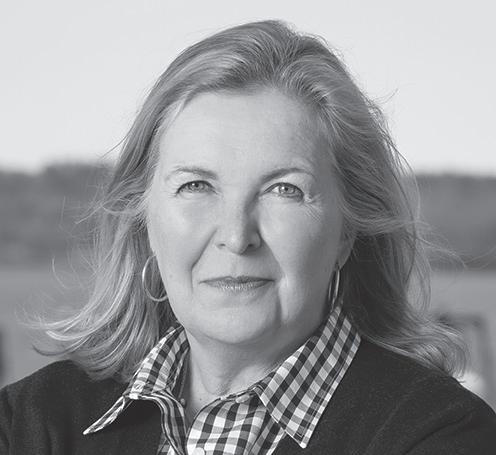
in protecting. While it is commonplace to talk about Maine’s cold, clean waters and our fresh-from-the-ocean catch, it is worth remembering that these are resources that we need to fight hard to protect. With 34,000 jobs in the balance and billions of dollars at stake for the Maine economy, investments in community planning, clean energy, fisheries management, and working waterfront access become not just important but truly urgent.
The next time you enjoy a plate full of Maine seafood goodness or support your working waterfront, know that you are a part of something much bigger—you’re helping build the longterm sustainability of an extraordinary asset that is uniquely Maine’s.
For more information about SEA Maine, go to www.seamaine.org
want—saltbox type or barn-roof type. I wanted a smaller place. Most everyone else wanted a large house. It wasn’t what we talked about tonight that was so far out. It was the quality of discussion. The ‘meeting’ was really lots of fun.”
David’s descriptions of his and the group’s interactions with the locals are especially colorful and sweet. The farmers and their families seem to accept these outsiders and help them. The group runs afoul of the law in “scrounging” for their house what they think are cast-off railroad ties, but matters resolve peacefully.
Dairy farmer Henry Peavey “treated me with kindness and respect and went out of his way to help us out,” David writes. When it came time to build the chimney on the house, which David volunteered to do, he realized he had no idea how to proceed.
“David, I’ll show you how to build a chimney,” Peavey tells him with a big smile, and mixed the mortar and started the work to get David going. Late that fall, Peavey shows up at the commune, hauling a shed on a trailer that was going to be torn down.
“Thought you might be needing this,” he says. And they did. It was impossible to heat the large house they’d built that first winter, and so they spent a lot of time in the shed.

Not surprisingly, the commune didn’t last, and David and the others settled down with spouses in their own places.
About 25 years ago, a different version of “intentional community” was created in Belfast, dubbed a “co-housing ecovillage.”
Imagine living “in a small neighborhood where everyone knows each other—a caring and stimulating environment where you all share some important core values…” was the pitch. The houses sell well-above median prices, and there is a common building for shared dinners. It’s a far cry from David’s experience scrounging lumber and trying to get a house up to livable temperatures in winter.
Can people live together in a group or is the family unit a more natural and fruitful arrangement? I’ll leave it to the sociologists to discuss. But David and his family have contributed to making Belfast a better place, and I’m glad they’re here.
Tom Groening—who lives with his wife in the woods away from other people— is editor of The Working Waterfront. He may be contacted at tgroening@ islandinstitute.org.
6 The Working Waterfront may 2024
Kim Hamilton is president of Island Institute, publisher of The Working Waterfront. She may be contacted at khamilton@islandinstitute.org.
HANGIN’ OUT IN PORT CLYDE—
This image from Port Clyde is dated to the early 1940s. The names written on the back of the print are: Lionel Heal, Alton Chadwick, Allison Wilson, Joan Wilson, Sandra Simmons, Maurice Powell, Ida Wilson, and Douglas Powell.

Listening led to harbor dredging funds
Frenchboro’s connection to mainland was shoaling
BY ALEX ZIPPARO
LAST MONTH, Sen. Susan Collins secured $500,000 in federal funding to dredge Frenchboro’s Lunt Harbor. The small island eight miles off Mount Desert Island relies on marine transportation and fishing for survival, so a safely navigable harbor is critical for the island’s everyday function.
The harbor, the main point for commercial fishing activity, is also the only access point for all mainland needs, including mail, groceries, medical services, and other supplies. The harbor had not been dredged in more than 50 years and because of that gap in maintenance, shoaling has severely limited harbor navigation, with access only possible during certain phases of the tidal cycle.
This new funding provides the financial capability to get the job done, enhancing access to the central hub for Frenchboro’s economic activity and basic community needs.
Serving islands takes a good listening ear and a keen eye for opportunity, and it also helps to be in the right place at the right time. The Frenchboro dredging project is a good example of that.
I took my first work trip out to Frenchboro nearly two years ago to meet with municipal officials and other community leaders about their needs, goals, and vision for the island. After spending the day touring the island with community members, I got back on the boat to return to the mainland, where I met Frenchboro resident Eric Best. As we made our way back to Bass Harbor, Eric asked me about my role at Island Institute. When I told him about how I engage with municipalities, he said “Maybe you’re the exact person I need to talk to! I am a new select board member and I want to get our harbor dredged.” I said I would see what I could do to help. Once I was back in the office, my colleague Nick Battista, Island Institute’s chief policy officer, and I reached out to the Army Corps of Engineers to get the ball rolling. From there, I worked with Best and the Army Corps of Engineers to analyze findings from a previously conducted harbor study for the island to confirm the need for dredging, which started the process to finally dredge Lunt Harbor.
While it was a relief to finally have all the pieces in motion, the timeline for project completion was years away. In my work supporting island needs, I regularly interface with Maine’s congressional delegation staff to help them understand the issues that impact our islands most so they can intervene when appropriate.
The harbor had not been dredged in more than 50 years…
In this case, Sen. Collins was able to help expedite the dredging project timeline though Congressional Directed Spending funds she secured.
The project will be completed by the Army Corps of Engineers in the next couple of years which has brought a sense of relief to the community.
The story of how Frenchboro got to this point illustrates how Island Institute serves communities along Maine’s coast. A lot of what my colleagues and I do is leverage internal and external resources to help islands and coastal communities meet their needs.
In this case, residents of Frenchboro communicated the need for dredging to Island Institute staff and entrusted
us to work with our federal partners to navigate a path to meet their goals. In a letter to Sen. Collins about the funding request, Frenchboro residents and members of the fishing community, Rachel Bishop and David Lunt said: “Island Institute has worked with the Frenchboro community for decades and have added their support for this project and the efforts to help us address the decreasing navigability of our harbor. They recognize the critical role that our harbor plays in the economic and community resilience of our island. The need for safe, reliable access to the inner harbor is critical for all aspects of island life and work.”
We couldn’t be more thrilled about this success story of how a collaboration between a community development organization and dedicated public servants can make a big impact on a small and mighty Maine fishing community.
Alex Zipparo is a community development officer with Island Institute, publisher of The Working Waterfront. They may be contacted at azipparo@islandinstitute.org.
7 www.workingwaterfront.com may 2024
column Editor: Tom Groening tgroening@islandinstitute.org Our advertisers reach 50,000+ readers who care about the coast of Maine. Free distribution from Kittery to Lubec and mailed directly to islanders and members of Island Institute, and distributed monthly to Portland Press Herald and Bangor Daily News subscribers. To Advertise Contact: Dave Jackson djackson@islandinstitute.org (207) 542-5801 www.WorkingWaterfront.com Island Institute Board of Trustees Kristin Howard, Chair Doug Henderson, Vice-Chair Shey Conover, Secretary, Chair of Governance Committee Carol White, Chair of Programs Committee Kate Vogt, Treasurer, Chair of Finance Committee Bryan Lewis, Chair of Philanthropy Committee Megan Dayton, Ad Hoc Marketing & Comms Committee Mike Boyd, Clerk Sebastian Belle David Cousens Mike Felton Nathan Johnson Emily Lane Michael Sant Mike Steinharter Donna Wiegle Tom Glenn (honorary) Joe Higdon (honorary) Bobbie Sweet (honorary) John Bird (honorary) Kimberly A. Hamilton, PhD (ex officio) THE WORKING WATERFRONT Published by Island Institute, a non-profit organization that works to sustain Maine's island and coastal communities, and exchanges ideas and experiences to further the sustainability of communities here and elsewhere. All members of Island Institute and residents of Maine island communities receive monthly mail delivery of The Working Waterfront. For home delivery: Join Island Institute by calling our office at (207) 594-9209 E-mail us: membership@islandinstitute.org • Visit us online: giving.islandinstitute.org 386 Main Street / P.O. Box 648 • Rockland, ME 04841 The Working Waterfront is printed on recycled paper by Masthead Media. Customer Service: (207) 594-9209
guest
New life for the last sardine cannery
Former Stinson’s plant gets assist from town
ANALYSIS BY JACQUELINE WEAVER
Editor’s note: Jacqueline Weaver serves on Gouldsboro’s select board.
When the auctioneer announced the new owners of the former Stinson sardine cannery in the Gouldsboro village of Prospect Harbor, the business partners had a deerin-the-headlights look. They had just spent more than $1 million (price, plus outstanding liens) for the 100,000-square-foot complex and more than 90 acres, but were not quite sure what they would do with it.
For 135 years, what is known locally as “Stinson’s,” after the name of the founder, was home to a sardine cannery. The last owner was Bumble Bee Seafood, which abruptly closed its doors in June 2010. It was the last remaining sardine cannery in the country. Two more businesses took over, one after the other. The 40-foot “Big Jim” billboard looming over the property for decades had held a giant can of sardines. It was repainted with Jim hoisting a wooden trap with lobsters—a reflection of those owners’ lobster processing operations.
Maine Fair Trade, the second lobster processor, moved its equipment out several years after purchasing the property in 2012, and focused its attention on a much larger seafood processing operation in New Bedford, Mass. What was looking more and more like a white elephant was purchased in 2022 by American Aquafarms, a company made up largely of Norwegian investors who proposed locating an industrial-scale salmon farm in Frenchman Bay and hatch eggs, process, and transport salmon out of the former Stinson plant site. But the state of Maine had other thoughts. The Department of Marine Resources terminated American Aquafarms’ permit application, citing
issues with the source of the eggs and the eggs’ genetic makeup.
On June 15, the property, consisting of a large office space and multiple, cavernous buildings, was auctioned and purchased by three local business people. Tim Ring had owned a paving company. Kevin Barbee and Josh Trundy are in construction. They had collaborated on projects over the years.
A single tenant was unlikely. No seafood operation had bid on the complex.
The price was $975,000 plus more than $300,000 in liens. They knew going into the auction that the property was zoned Commercial Fisheries/ Maritime Activities, which meant only “functionally water dependent” business could take place within the 11 acres or so on the water. This meant that the new owners could not, for example, store blueberry boxes—which one potential renter had inquired about. But they also knew how important the property was to the town of Gouldsboro. People overall wanted to see ongoing business operations on this centrally located, waterfront property in town. They also wanted commerce that was in keeping with the scale of the town. The partners also hoped the town could help them create a zoning environment that would help pave the way to profitability. A single tenant was unlikely. No seafood operation had bid on the complex. Planning board members scratched their heads about what could be done with what they feared could remain a ghostly, hulking presence in Prospect Harbor, albeit with multi-million-dollar views.
But Bill Zoellick, a resident who is very active on climate resiliency preparations, and Becky O’Keefe, who had opposed the industrial salmon farm and was hoping an array of small, marine related businesses could fill the buildings, hunkered down and did some investigating. Under shoreland zoning, Zoellick said, a town has six options: Resource Protection; Limited Residential; Limited Commercial; General
Island Institute awards storm recovery grants
Over 50 waterfront businesses get funding
ISLAND INSTITUTE, a community development nonprofit serving Maine’s island and coastal communities, has delivered a total of $250,000 in business resilience storm response grants to 52 waterfront businesses in the wake of the back-toback January storms.
The grants were awarded to fishing cooperatives, lobster wharves, and processing centers that are relied upon by the fishermen, distributors, and retailers that are the backbone of Maine’s marine economy. These grants are supporting 540 working waterfront jobs and helping rebuild infrastructure relied on by 1,195 commercial vessels.
“Building back along Maine’s coast will require a sustained programmatic and policy effort,” said Kim Hamilton, Island Institute president. “These grants are just one part of our response and helped jumpstart recovery and ignite a sense of hope. When you’ve just watched an extraordinary storm wash away your business and decades of hard work, it’s good to know that your community has your back.”
Within a week of the first storm, Island Institute had launched its storm response grant program, received applications, and began sending funds to critical working waterfront businesses along Maine’s coast.
On Mount Desert Island, Thurston’s Lobster Pound was particularly hard hit, suffering damage to its wharf.
“Island Institute was the first organization that was right there within days after the storm, offering a grant to help rebuild,” said Derek LaPointe, general manager. “And we immediately put that towards lumber cost because we needed to get stuff built so we can serve the 22 lobstermen we support.”
From bait to plate, the seafood sector contributes more than $3.2 billion in total economic output annually to Maine, supports more than 33,300 jobs statewide, and relies almost entirely on the 20 remaining miles of working waterfront infrastructure in our state. Without safe and reliable wharves, docks, and access ramps, Maine’s fishing communities are at risk of grinding to a halt.
To address the importance of working waterfront infrastructure for our coastal economy, Island Institute aimed these grants along with programmatic and policy efforts toward rebuilding with future resiliency in mind. Each applicant was asked if they had identified ways to rebuild to be more resilient and was offered help from Island Institute staff on how to plan for future storms.
Island Institute targeted these grants toward communities that are major contributors to the marine economy, were highly impacted by the storms, and are at particularly high risk of future damage due to climate change.
The institute also hosted two public webinars, the first—held three days after the second storm—provided
Development I; General Development II, and Commercial Fisheries/Maritime Activities.
After weeks of conversation between Zoellick and the Department of Environmental Protection, the town at a special town meeting in December voted unanimously to change the designated zoning to General Development District I with added restrictions to keep the site as working waterfront. The planning board also included language that prohibits residential use within the designated area and requires that 25 percent of the site be used for marine activities.
General District Development I applies to areas of two or more contiguous acres devoted to commercial, industrial, or intensive recreational activities, or a mix of such activities. Those activities can include, but are not limited to, areas devoted to manufacturing, fabricating or other industrial activities; wholesaling, warehousing, retail trade and service activities, or other commercial activities.
It also includes intensive recreational development and activities, such as, but not limited to, amusement parks, racetracks, and fairgrounds. Areas having patterns of intensive commercial, industrial, or recreational uses are recognized as well. The matter then went to the DEP for approval. If no word was received in 45 days, the town could consider the new zoning in place.
The deadline for comment passed in March. Suddenly, the white elephant had a future. The DEP explains in its Maine Shoreland Zoning document that the development of a waterfront management strategy can be a complex process. “There are many different techniques that can be used to tailor an ordinance to reflect local goals and resources,” it is stated in the shoreland ordinance. “But other zoning variations are also possible which may be much more specific about what types of functionally water-dependent uses should be permitted, make use of more than one type of waterfront district, may include standards for assessing the impact of proposed development on water dependent uses, and may include specific provisions to encourage certain types of public benefits.”
attendees with timely information from leaders of the Maine Department of Marine Resources, Maine Emergency Management Association, and Department of Economic and Community Development about reporting storm damages and applying for assistance. The second focused on storm science, explaining how climate trends are likely to impact our coast in the coming decades.
Island Institute’s storm response efforts are part of its ongoing work in helping Maine’s island and coastal communities navigate changes in our climate and economy, with recent efforts that include:
Supporting LD 2225, legislation proposed by Gov. Mills which, if approved by the legislature, will result in the investment of $50 million to help rebuild storm damaged infrastructure, including working waterfronts.
Supporting Gouldsboro, Swan’s Island, Frenchboro, Matinicus, and Isle au Haut in applying for $50,000 grants through the state’s Community Resilience Partnership for infrastructure resilience projects.
Leading the development of a working waterfront strategy for the Coastal and Marine Working Group of the Maine Climate Council that focused on both the needs of privately owned working waterfronts and the importance of resilience upgrades to both public and private working waterfronts.
For more information, see IslandInstitute.org.
8 The Working Waterfront may 2024
‘Attainable’ housing: lessons learned
Stonington panel discussion offers successful approaches
BY TOM GROENING
Deer Isle and Stonington and Mount Desert Island are separated by a short hop across Blue Hill Bay. But if housing shortages are to be addressed, those two regions should tailor their work differently, and consider solutions within the context of a micro-region.
That was one of the takeaways from a March 20 panel discussion at the Stonington Opera House, part of a community Talk of the Towns series, this one devoted to affordable housing. The series concludes April 24 with a discussion of small-scale aquaculture.
Other recommendations from panelists on housing included the importance of:
• working to educate banks on financing unusual housing projects
• seeking private funding
• paying attention to the “visual cues” of public housing to avoid opposition from neighbors
• focusing on what moderator Linda Nelson called the “missing middle,” those whose incomes were not low enough to qualify for assistance, yet not wealthy enough to purchase in the area
Robert O’Brien of Camoin Associates, an economic development consulting firm, said part of the acute shortage of affordable housing is the result of “a decade of under-production” after the Great Recession that began in late 2008. Along with the steep drop in demand for houses, regulations for lending for housing tightened, further limiting construction.
One of the housing successes in the region is the recently completed tenunit complex on Deer Isle, developed by the nonprofit Island Workforce Housing group.
Founder Linda Campbell said the Oliver’s Ridge project got off to a bumpy launch.
“We started it during COVID,” she said, with construction material costs skyrocketing and contractors busy elsewhere. Still, “We came in relatively close to what our budget was,” in large part because of “thousands of hours of volunteer work.” Remarkably, no public funds were used.

Marla O’Byrne, executive director of Island Housing Trust, described how the effort to preserve Jones Marsh on MDI led to her group working with Maine Coast Heritage Trust to put the land into conservation easement while also building ten housing units. The houses may be purchased, but the land is leased.
“Nobody can afford to build housing now without subsidy,” said Mark Primeau of the Genesis Fund, a Maine nonprofit that loans money for housing, referring to private housing development companies.
Subsidies may be available for projects that serve households with less than 80% of the area median income, or AMI, which in Stonington, is about $68,000 for a family of four. Instead, Primeau said, communities want projects that serve families making 120% of AMI.
“Nobody can afford to build housing now without subsidy.”
—MARK PRIMEAU
“We raised $1.8 million in a year and a half,” Campbell said.
Jim Fisher, Deer Isle’s town manager, credited the “diverse skills on the committee” overseeing the project, which included an architect, someone working in finance, and a builder.
On MDI, an unusual collaboration succeeded in building workforce housing. Noel Musson of The Musson Group, a planning and permitting consulting firm, said the Island Housing Trust volunteer group wisely began by thinking island wide.
“Think about housing as a microregion,” he advised, seeking solutions that may only work in one area.
“We’re pretty dark in the winter now,” Nelson said of Stonington, where she serves as the town’s economic and community development director, meaning that yearround residents are few. Plumbers, electricians, and carpenters must commute to the island, she said, along with many of those working on lobster boats.
Fisher echoed Nelson’s description of Stonington lacking much year-round population.
“This is a very desirable place to be,” he said. “A lot of people want to be here, if only a few weeks a year.” Nelson said that Stonington’s population has declined over the last decade, though the pandemic brought an influx, at least temporarily.
“We really would want them to stay,” she said.
The stigma associated with public housing projects was also discussed.
“One of the things we have to talk about out loud is how a neighborhood looks,” O’Brien said. The recent straw poll in Cumberland in which a 102-unit building project was rejected
was cited as evidence of what is often an uphill climb in establishing subsidized housing.
Musson, who grew up on MDI, said people don’t like change, and so developers should carefully consider the “visual cues” so the buildings fit into the community.
“Litigation as planning is a terrible approach,” said Jim Fisher, town manager for Deer Isle. “It’s expensive.”
“You have to be above the fray,” Musson said of the offensive comments


that often follow a proposal to build housing for people with lower incomes.
Even the jargon on the issue is charged. Panelists, responding to a question from the audience, said “affordable housing” is defined by federal income standards.
O’Byrne defined it as “housing for people who are under the median income.”
O’Brien’s definition was more concise and perhaps more clarifying: “attainable housing.”


9 www.workingwaterfront.com may 2024
Independent. Local. Focused on you. Boothbay New Harbor Vinalhaven Rockland Bath Wiscasset Auto Home Business Marine (800) 898-4423 jedwardknight.com
The Oliver’s Ridge workforce housing project on Deer Isle, shortly after construction concluded.
Despite regeneration ability, sea stars are dying
Sea stars—and their five heads—face climate threat
BY LYNDA DEWITT/THE MAINE MONITOR
Turns out we’ve been looking at starfish all wrong.
First, they’re not fish. They belong to a group of marine invertebrates called echinoderms, which also includes sea urchins, sand dollars, and sea cucumbers. Starfish now go by the classy common name of sea stars.
Then there’s the matter of those arms. It’s true, sea stars can regrow, or regenerate, if an arm should be torn off by, say, the sharp bill of a hungry sea gull. But recent studies show those arms are actually heads. So instead of a body with five arms, sea stars have only heads.
Something else about sea stars has confounded scientists: What is killing them?
“All marine life is struggling to adapt at the speed of climate change,” said Andrew McCracken, a Topsham native and Ph.D. student at the University of Vermont. “The Gulf of Maine, which is warming faster than other ocean waters, is an area of particular risk.”
Besides waters that are warming and becoming more acidic, possible stressors include low oxygen levels (due to increases in bacteria in the water using up the oxygen), and perhaps a virus.
Whatever the cause, what happens to sick sea stars is fodder for a horror flick. A white, gooey lesion on its spiny skin soon spreads, causing the tissue to soften and twist. Within days the sea star can completely disintegrate—a sickness called sea star wasting disease.
The disease traces back to at least the 1970s, when similar symptoms were first observed and documented in Maine and elsewhere on the East Coast,
said McCracken, who is studying how marine animals adapt to stress.
Then in 2013, large-scale die-offs began on the Pacific Coast from Mexico to Alaska. On the East Coast, with fewer sea star species and smaller populations, the die-offs haven’t been as dramatic.
But it’s happening regularly, from Acadia National Park to at least Massachusetts, said Dr. Melina Giakoumis, the associate director of the Institute for Comparative Genomics at the American Museum of Natural History. And, she adds, it seems to be happening more frequently and more severely.
Maine’s two common sea star species, the Forbes sea star (Asterias forbesi) and the northern sea star (Asterias rubens), have both been listed as “species of greatest conservation need” by the state. The 2016 listing claims sea stars are “undergoing steep population declines,” which, if unchecked, likely will lead to “local extinction and/or range contraction.”
Since sea stars aren’t a commercial species, the Department of Marine Resources is monitoring the population rather than working on mitigation.
Yet Maine’s sea stars are considered keystone species, meaning “they have a disproportionately large effect on their community,” said Giakoumis. “It’s important to protect them because they help keep other species in check, which increases stability and resilience in the entire ecosystem.”
The sea stars may already be helping themselves survive the wasting disease. Giakoumis has documented that the hybridization of Maine’s two
Feds provide funds for Lincolnville terminal
SEN. SUSAN COLLINS announced that the Maine Department of Transportation will receive a grant award of $7.1 million through the U.S. Department of Transportation’s Ferry Service for Rural Communities Grant Program.
The funding will go toward upgrading and modernizing the ferry terminal in Lincolnville to better meet current and anticipated future demand. Earlier this year, Collins wrote DOT Secretary Pete Buttigieg in support of the funding request, which originated with the Maine DOT.
“The Lincolnville ferry terminal plays a crucial role in the daily lives of local residents and businesses alike, providing freight and postal services while transporting students to school and people to their jobs,” Collins noted. “This investment will help to ensure safe and reliable transportation service for the estimated 180,000 passengers that travel to and from Islesboro every year.”
Earlier this year, Collins and Rep. Chellie Pingree announced $33

major sea star species is occurring from the southern Canadian Maritimes to New England.
“This adaptation perhaps provides genetic variation the species need to survive,” she said.
McCracken also wants to know if and how sea stars might adapt and survive. Last spring he was awarded a three-year National Science Foundation Graduate Research Fellowship to study how thermal extremes impact physiological changes in echinoderms, work that has specific relevance for the Gulf of Maine.
“By the time it takes to unravel the possible multiple causes of the disease, it may be too late,” said McCracken. “Working to protect the surviving populations is something I’m excited about. Are there actual traits that make them immune? Do they have the genetic capacity to adapt? These are the questions I hope to help answer.”
Getting the answers will take help from the community. Giakoumis is
working on an app that will allow citizen scientists and trained scientists to plug in data on when and where they see sea stars, and if they observe evidence of the disease.
“Sea stars tend to be more visible in the summer when they come into shallower waters,” said Giakoumis. “In winter months they tend to stay in deeper water.”
We can help sea stars and all marine life now by “protecting what we can control,” said McCracken. “By not overfishing and not raking the sea floor, we will protect marine habitat, and give sea stars and other marine life the best chance of survival.”
This story was originally published by The Maine Monitor, a nonprofit and nonpartisan news organization. To get regular coverage from the Monitor, sign up for a free Monitor newsletter at TheMaineMonitor.org.
million in Bipartisan Infrastructure Law funding to support, improve, and modernize passenger ferry service in Maine. The funding was awarded to Maine’s DOT through new ferry grant programs to support passenger ferry systems as they transition to climatefriendly technologies.
The current ferry terminal, constructed in 1959, is reaching the end of its service life. In addition to necessary modernization, improvements are also needed to accommodate a new plug-in hybrid ferry, which is expected to be delivered in 2027. This vessel will primarily operate on battery power, supported by a diesel backup system, and will have the capacity to transport ten additional vehicles.
As one of the six island communities that the Maine State Ferry Service serves, the Islesboro route is the most traveled, serving roughly 600 year-round residents. The route carries roughly 180,000 walk-on passengers and more than 80,000 vehicles every year.

Michaud wins ‘officer of the year’
Maine Marine Patrol Officer Alex Michaud received the 2024 Maine Lobstermen’s Association Officer of the Year Award during the Maine Fishermen’s Forum in Rockport in early March.
The award is presented to a Marine Patrol Officer who has demonstrated outstanding service in support of the lobster industry. Michaud, who joined the service in 2017, serves in the St. George-Warren area.
In addition to strong patrol work, search and rescue support, and community relations, Michaud was recognized for investigating many lobster fishery violations including cases related to V-notching, untagged traps, fishing under suspension, and trap limits. A bureau of the Maine Department of Marine Resources, the Maine Marine Patrol provides law enforcement, search and rescue, maritime security, public safety services on Maine’s coastal tidal waters.
10 The Working Waterfront may 2024
Young, healthy sea stars were found in Acadia National Park.
Maine Marine Patrol Officer Alex Michaud, center, receives the 2024 Maine Lobstermen’s Association Officer of the Year Award during the Fishermen’s Forum. From left are and MLA board president Kristan Porter Department of Marine Resources Commissioner Patrick Keliher, Sgt. Matthew Wyman, and Major Rob Beal.
James Croll and sea level rise
A genius janitor was a real-life ‘Good Will Hunting’
BY STEVE ZOLOTH
“THAT’S THE WAY it looks from here” was the jaunty sign-off of Lou McNally, Maine Public Radio’s longtime weather forecaster, and we knew a storm was coming. But king tides and climate change played another game.
On Jan. 13 the Maine coast was inundated. Water flowed into hundreds of towns, along the working waterfront. Businesses and roads were awash with water.
On Vinalhaven, the town’s parking lot had whitecaps as the storm moved through and the main street was impassible. On North Haven, Brown’s Boatyard, a century-old business, saw its pier and workshop damaged. Portland’s tide gauge read 14.57 feet, a new record.
There is no question that the sea level is rising. From Miami to Maine, stories of flooded streets, homes, and businesses come with each new tide. On the West Coast, multimillion-dollar houses teeter on cliff edge as storms erode the land beneath them.
Yet we look at these events in isolation. A flooded home, a shopkeeper throwing away damaged goods, and police directing traffic away from a flooded street. But seeing these events across the breadth of the East Coast suggests more—sinking coastlines, disrupted habitats, and rising seas.
Who first called attention to this problem? When did science begin to understand the concept that land could sink, glaciers melt, warming seas could rise, and contemplate the flooding that could occur?
Surprisingly, there is no single person who could be seen as the originator of the modern idea of sea level rise. It goes as far back as Archimedes who demonstrated water displacement, but it was in the 1800s that climate became part of the scientific discussion. And it was in the 1880s that the self-taught son of a Scottish farmer sat down and wrote his text on geography. While he did not specifically discuss rising sea levels he was an early contributor to the possibility of changing coastlines.
He was James Croll, whose amazing history produced an amazing man. He was born in poverty on a croft, a Scottish term for a small parcel of land on a large estate. When he was three, the lord told his family to leave, and they relocated to poor bottomland. Croll left school to work on the farm at 13.
At 16 he became a carpenter, a trade he pursued until an injury made it too painful to continue. He then held an astonishing number of jobs from insurance salesman to newspaper clerk, from temperance hotelier to tea salesman and tea merchant.
Through it all, as he wrote in his memoir, was “a strong and almost irresistible urge to study.” Without much formal schooling, he taught himself by reading Penny Magazines, founded by the Society for the Diffusion of Useful Knowledge to provide education to the working poor.
Eventually, Croll found work as a janitor at a Glasgow museum. The museum was open a few hours each day so he had ample time to study, mastering physics, astronomy, and
geology. He later recalled, “I have never been in any place so congenial to me as that institution.”
In 1864, this self-taught scientist began to publish in the most respected scientific journals of the times, contributing his thoughts on geology, tides, and the earth’s rotation. His notable paper: “On the physical cause of the change of climate during geological epochs” brought scientific recognition.
By 1875, his reputation had grown, and this son of a poor Scottish farmer without much formal schooling was inducted into the Royal Society of London and granted an honorary doctorate from St. Andrews. James Croll, a janitor, a genius, was very much like the Matt Damon character in Good Will Hunting.
But the story doesn’t end there. Sir Charles Lyell, head of the Geological Survey of Scotland, read his works and offered him a position as office secretary, since Croll couldn’t be given the appropriate title of geologist without formal education.
As secretary, he was the keeper of maps and surveys and continued to publish papers on ice ages, variations in the earth’s orbit, climate, glaciation, and ocean currents. In 1867 he published a paper describing how the melting of ice in Antarctica could elevate sea levels. Essentially, he was describing how sea levels might respond to melting ice sheets in a warming world, a century ahead of his time.
In 1965, almost 100 years after Croll, a team of scientists wrote to President
Lyndon Johnson warning of the effects of climate change and the potential for sea level rise. And in 2022, scientists examining 2,000 years of global records determined that the significant changes in sea level began with the transition to fossil fuels at the dawn of the Industrial Revolution.
Finally, NOAA, also in 2022, released a detailed report predicting rises in sea levels on the East Coast of 10-13 inches by 2050.
Now we know that sea level rise is driven by a combination of factors associated with climate change. The ocean is warming, and warm water expands; there is water entering the sea from glacial melt, as well as the potential catastrophic melting of ice sheets. It was the rising seas combined with the January storm surge that overwhelmed Maine’s working waterfront.
Climate change is now a topic of daily discussion, with worldwide attention on the low-lying islands in the Pacific. In Maine as elsewhere on the East Coast, we have realized that it takes a community to work together to find solutions; solutions for Portland are different than solutions for Vinalhaven. Yet the problem is also one for all of us together.
The scale is enormous, the cost is high, and the effort needed can only be accomplished by recognizing time is short and by working together.


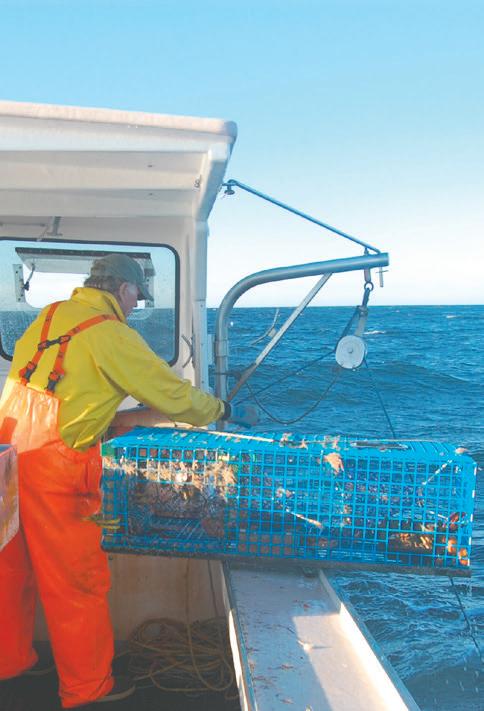
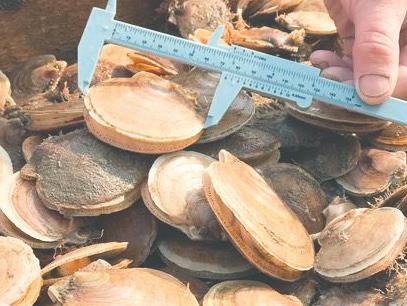





11 www.workingwaterfront.com may 2024 G.F. Johnston & Associates Concept Through Construction 12 Apple Lane, Unit #3, PO Box 197, Southwest Harbor, ME 04679 Phone 207-244-1200— ww w. gfjcivilconsult.com — Consulting Civil Engineers • Regulatory permitting • Land evaluation • Project management • Site Planning • Sewer and water supply systems • Pier and wharf permitting and design
John Martin, Bud Staples, and Elsie Gillespie chat around the woodstove at the annual town meeting.
13 www.workingwaterfront.com April 2020
Gerald “Punkin” Lemoine Bud Staples
Zoloth teaches public health at Northeastern University in Boston. He and his family spend summers on Vinalhaven.
Steve
guest column Sea Farm & Commercial Fisheries Loans FINANCING FOR MAINE’S MARINE BUSINESSES For more information contact: Nick Branchina | nick.branchina@ceimaine.org | (207) 292-1250 Hugh Cowperthwaite | hugh.cowperthwaite@ceimaine.org | (207) 292-1102 Funds can be utilized for boats, gear, equipment, infrastructure, land and/or operational capital. Like our stories, columns, and photos? Check us out and “like” The Working Waterfront on Facebook!
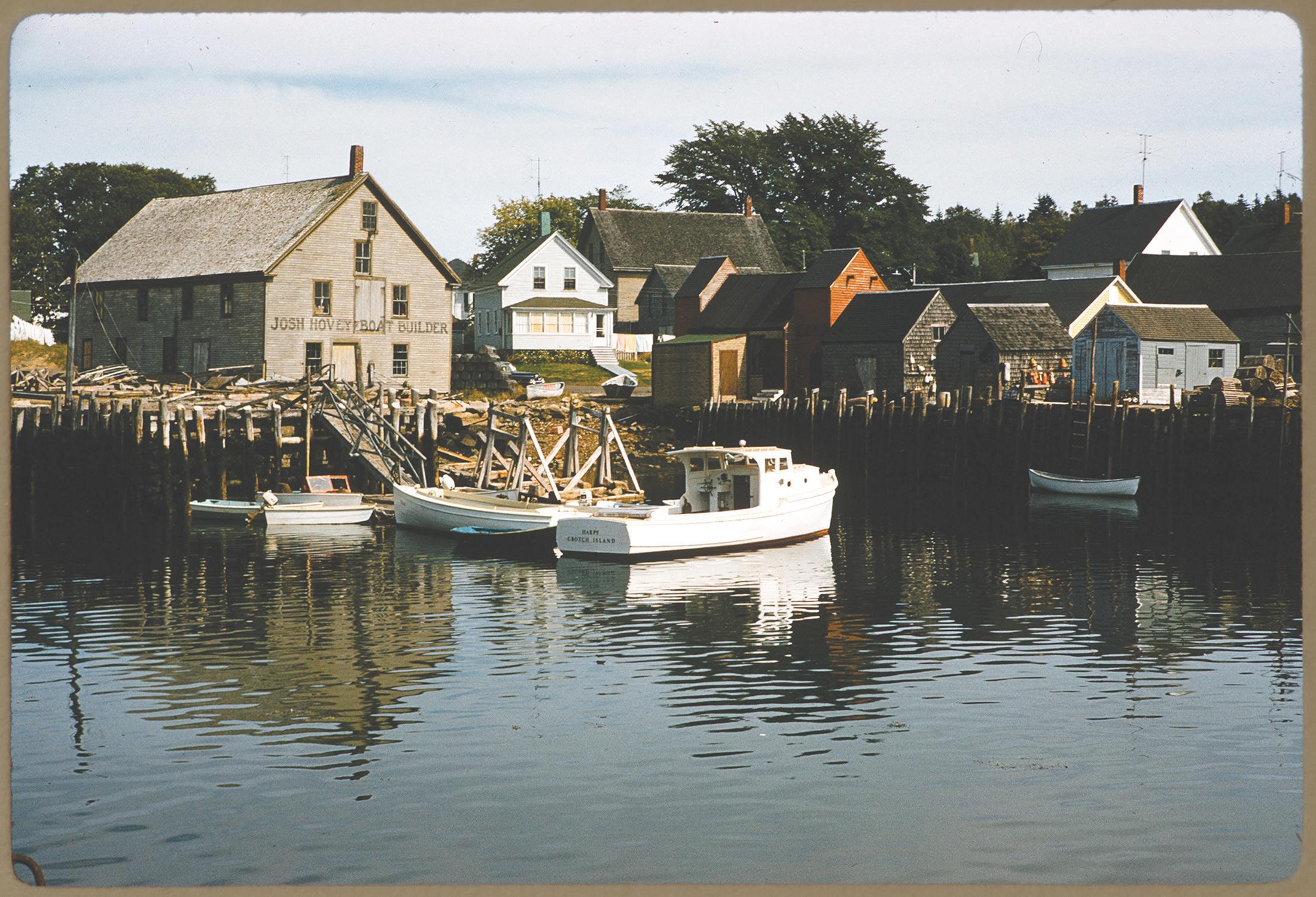
A casual Vinalhaven visual survey
Eliot Elisofon’s love affair with island in collection
Prominent mid-20th century documentary photographer and photojournalist Eliot Elisofon fell in love with Vinalhaven and bought a farmhouse on Crockett’s Cove in 1942; it became a summer retreat for him and his family. He cherished his time in this bucolic place and was very involved in island life. This inspiration led to the casual photographic survey he made of the island and its inhabitants. Though most of his professional work is in the hands of major museums and galleries, Elisofon’s daughter Elin wanted the Vinalhaven photos to reside close by; she donated the group of nearly 2,000 slides and negatives, shot between 1940 and 1970, to Penobscot Marine Museum in 2020, a sampling of which are reproduced here.
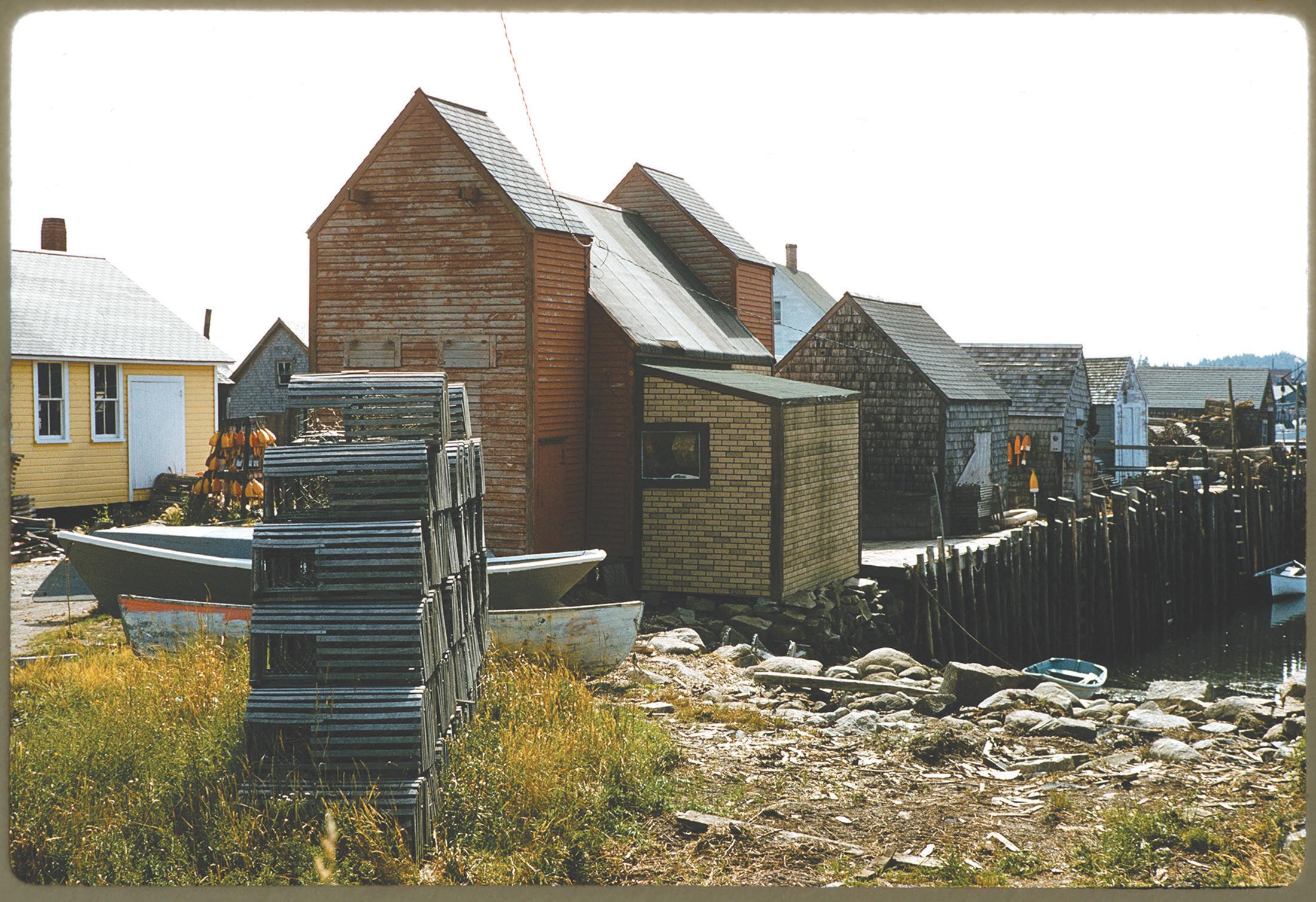
12 The Working Waterfront may 2024
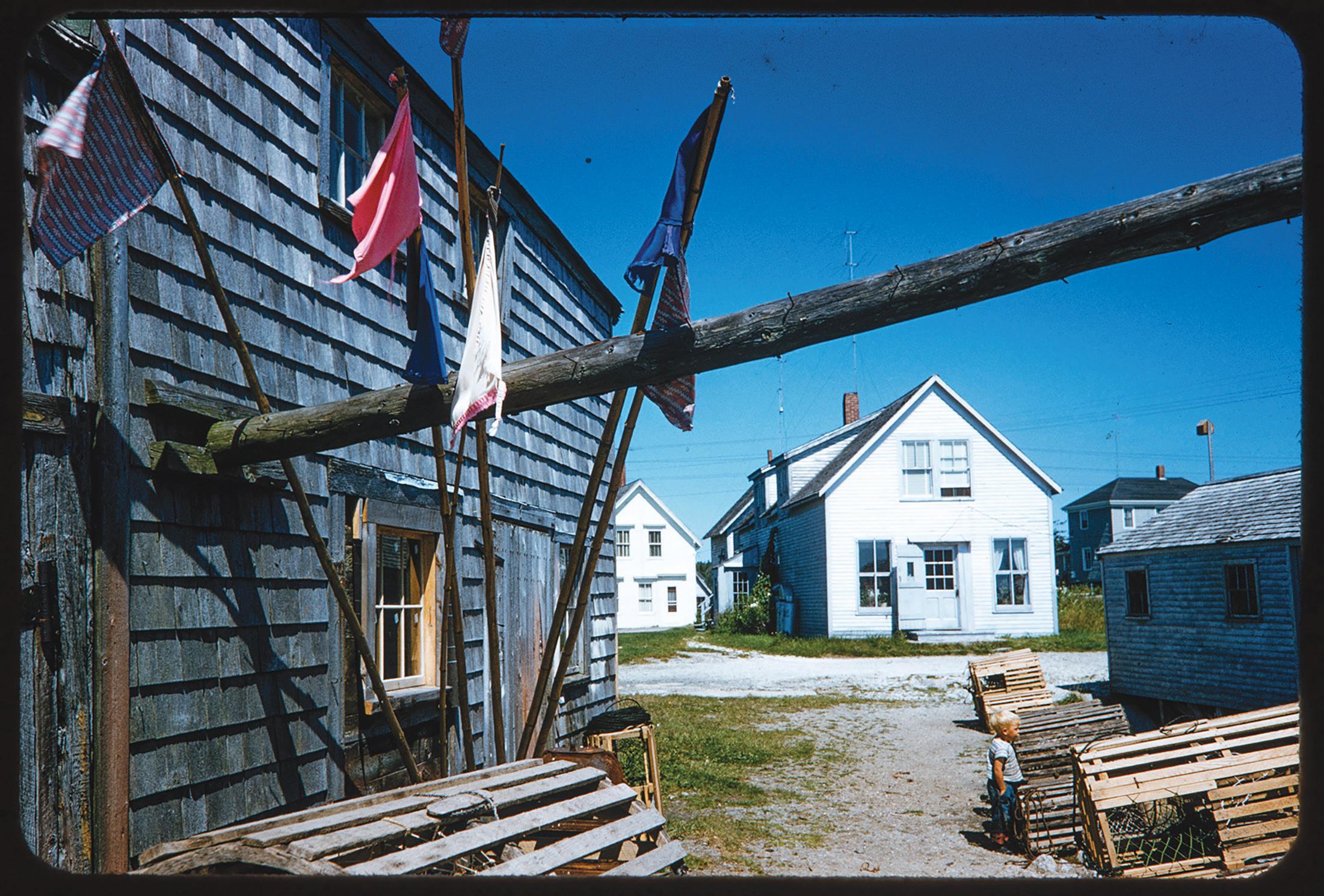


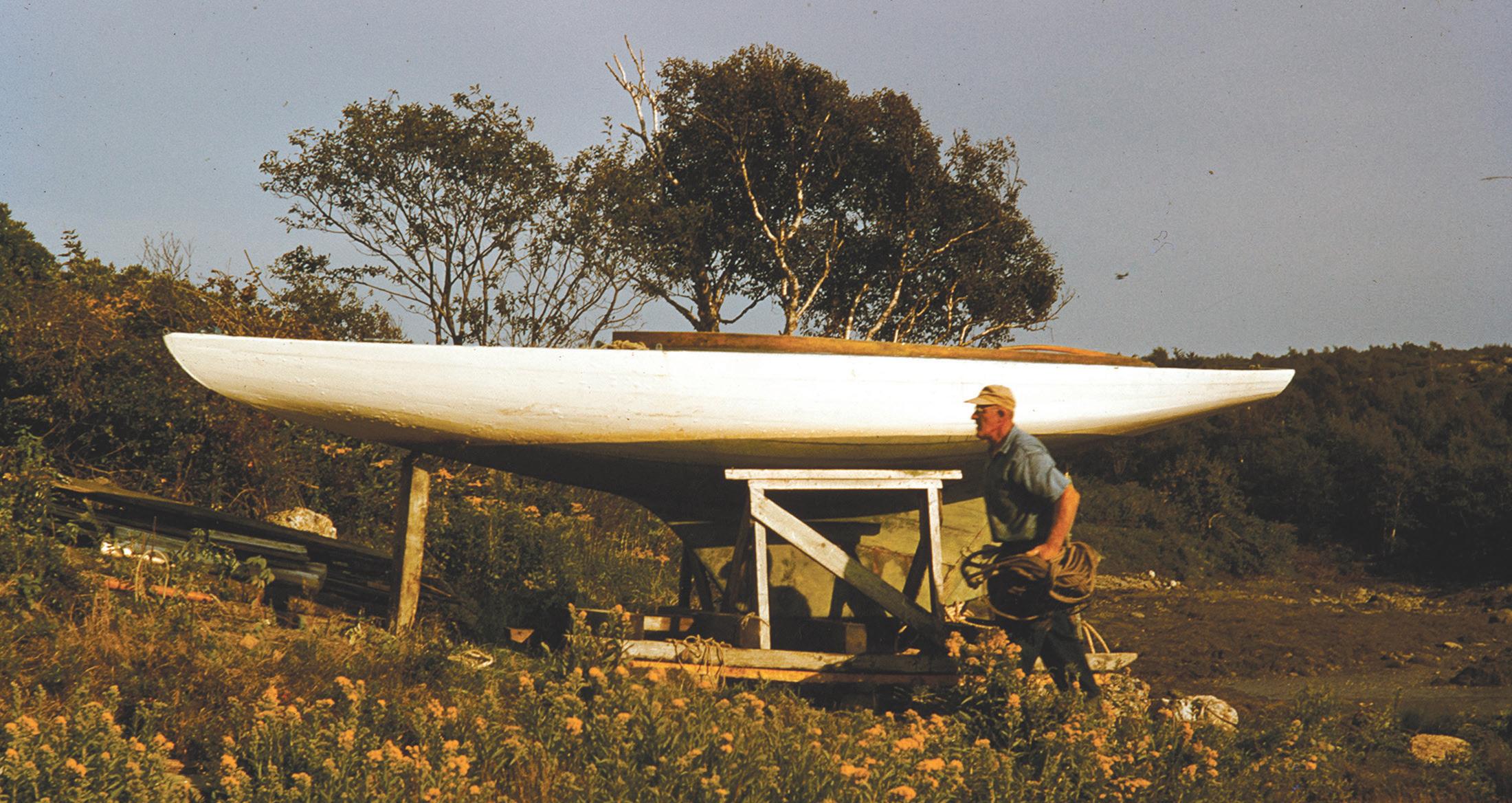
13 www.workingwaterfront.com may 2024
The passing of a fisheries icon
Frank O’Hara Sr. dies at 91 in Camden
This story first appeared in National Fisherman and is reprinted here with permission and gratitude.
Francis J. O’Hara Sr., president of the O’Hara Corporation, passed away last summer at his home in Camden at the age of 91. If there is a name that’s synonymous with Maine’s fishing industry, it’s Frank O’Hara.
The O’Haras started building boats and developing a vertically integrated seafood company in the early 20th century. The family’s first boat, the F/V Francis J. O’Hara Jr., was built in 1904 and sunk by a German U-boat during World War I.
Gradually, the O’Haras moved from T-Wharf in Boston to Portland, Rockland, and Lubec. Over the century, the O’Hara Corporation increased its footprint to include New Bedford, Mass.; Seattle, Washington; Dutch Harbor, Alaska; and Zhuange, China. The company headquarters remains in Rockland.
From the age of sail and sextants to the age of 3,500-horsepower engines and satellite communications, the O’Hara family has defined and been defined by the commercial fishing industry.
Born in 1932 in Boston, Frank O’Hara began working for his father’s company in Rockland at a young age. In those years the O’Hara vessels, including four 85-foot trawlers, caught and processed millions of pounds of redfish, breaking records for landings. The company froze much of that fish to feed U.S. troops during World War II.
From their company’s beginnings, the O’Haras had a knack for making the right moves, understanding a business intrinsically connected to an unpredictable resource—wild fish.
Frank Sr. worked with his brother on the docks through school. After a stint at Boston College, he found his life-long mate, Jill, and they married and
began their life together. Frank took the helm of the company in 1955.
At that time, Maine fishermen followed redfish past Newfoundland, and occasionally, all the way to the Labrador Sea. The O’Hara fleet operated out of Rockland and consisted of several side trawlers, all named after family members. It was not long before a change in fish stocks required the fleet to switch from ocean perch (redfish) to groundfish including haddock, cod, pollock, and flatfish.
After the Magnuson-Stevens Fishery Conservation and Management Act established the 200-mile limit in 1977, a change in the fishery required a different style of boat, which began the shift to stern trawlers that were built from 1979 to 1984. The O’Hara’s Araho was one of the first stern trawlers with a steerable nozzle or rudder which increased horsepower and made steering more efficient.
Frank was also one of the first to install a processing room below deck to allow crew to head and gut the fish in better conditions, along with an automated gutting machine designed in Nova Scotia. Frank built four sister ships to the Araho—the Freedom, Ranger, Enterprise, and Defender, all named after America’s Cup winners.
By establishing its operations in Rockland, F.J. O’Hara and Sons gained an advantage of being closer to the rich resources of the northern edge and northeast peak of Georges Bank, but when Canada asserted control over some of those grounds, the O’Hara fleet lost access.




“We suffered for three or four years after that,” said Frank Jr. Frank Sr. sent bigger boats to the tail of the Grand Banks, in international waters. It took nearly a week steaming for the boats to get there, then they fished like mad for five or six days, and then steamed home loaded with flounder.
The lack of access eventually led the O’Haras to change the course.
“We purchased an abandoned oil supply vessel and converted it to a factory processor, the Constellation, thinking we’d do squid, mackerel, and butterfish. But that didn’t work out as we hoped. It was getting hard fishing on the East Coast. The factory in Rockland was closing down due to the lack of fish. We decided to look west and with the help from Sewall Maddocks, who ventured to Alaska and came back and said there’s some fish out there, a decision had to be made,” Frank Jr. remembered.
“We took the Constellation out first, headed for the Panama Canal. Just outside Jamaica, we blew one of the main engines. I can remember my father saying, ‘This is crazy. We should have never done it,’” Frank Jr. said. “But after 1990 we were established in Alaska and then we focused on getting more boats out there.”
Since the move to Alaska, the O’Hara operation in Rockland shifted to catching and selling herring for lobster bait and catering to both lobster boats and pleasure craft as a marina.
Frank Sr. was connected to Connors Brothers of Black’s Harbor, Nova Scotia, the largest sardine producer on the East Coast. Connors Brothers were not allowed to own U.S. fishing boats, so the O’Haras purchased the Atlantic Mariner and converted it to a seiner/pair trawler to fish for herring and mackerel.
“Soon after, we became partners with long-time herring fisherman, Alfred Osgood of Vinalhaven. This put us on the map and in a great position to supply the coast of Maine lobstermen with a chilled, salted product to be used for catching lobster,” Frank Jr. said.
Frank Sr. was a driven man who put the crews of the boats, and the employees of the business first. “He always said the people do not work for us, they work with us,” says Frank Jr.
“He went to his office every day until he was in his early 80s,” adds Frank Sr.’s grandson Frank III. “He was always there when I was young. He taught me how to drive a truck, operate a forklift, and pick up trash around the marina,” he said.
“As he got older, he was less focused on the business and more focused on the family,” says Frank Jr.
Frank Sr. took the reins of the company and pushed it, even if reluctantly at times, into new territory. His death leaves a big hole in the fishing industry, but he has left a legacy to fill it. The O’Hara Corporation has provided careers not only for his children and grandchildren, but the next generation as well.
14 The Working Waterfront may 2024
The Francis J. O’Hara Jr., built in 1904.
Frank O’Hara Sr., center, Frank Jr., right, and Frank III, left, in Rockland. Frank Sr. was at his desk at the O’Hara Corporation’s Rockland headquarters until age 81. PHOTO: O’HARA CORP.
Frank O’Hara Sr., right, washing penboards for his father in 1950, saw the heyday of the company’s Rockland operations, from redfish in the 1940s to the shift of fishing operations to Alaska in the 1990s. PHOTO: O’HARA CORP.
Frank O’Hara Sr.
COA names new president
Dr. Sylvia Torti succeeds Darron Collins
THE COLLEGE OF THE ATLANTIC board of trustees has announced its unanimous selection of Dr. Sylvia Torti as the college’s seventh president.
Torti, an accomplished writer, ecologist, and innovative academic leader with 15 years of experience in higher education, will succeed president Darron Collins upon his retirement at the end of the 2023-24 academic year. Torti will begin her tenure as president on July 1.
“Dr. Torti is the perfect person to carry College of the Atlantic into our second half century,” said trustees chairwoman Beth Gardiner. “Her intellectual curiosity, natural leadership, incredible creativity, passion for the human experience, and ability to connect with others on a deep, personal level will allow her to inspire, energize, and uplift all members of the COA community.”
From 2012-2023, Torti served as dean of the Honors College at University of Utah, a liberal arts college nested within a large research institution, where she achieved ambitious goals through dedicated strategic planning, including tripling the diversity of the student body as well as increasing the number of outof-state students. She also created a successful office to mentor for nationally competitive scholarships and initiated and implemented a vision for globally oriented, integrated curricula in ecology, health, and human rights. Torti, who is from a bicultural Latinx background and has lived and worked globally, is a collaborative leader with a passion for experiential, interdisciplinary learning, shared governance, and centering the principles of diversity, equity, and inclusion in today’s higher education landscape.









“Dr. Torti fully understands the moment we are in, the important role that COA has in the world of higher education, and how vital it is to make sure that diversity, equity, and inclusion are central to how we evolve as a college at this time,” Gardiner said. “One of the things that we’re so inspired by is Dr. Torti’s proven track record in this area, along with her deep personal commitment. She has a firm grasp of the importance of attracting and retaining diverse students and faculty and expanding the types of classes offered so that we can better reflect the world around us.”
Torti holds a Ph.D. from the University of Utah School of Biological Sciences and a B.A. from Earlham College. She boasts a 30-year record of publication, including multiple scientific research papers, research, and opinion pieces on methods of pedagogy, two novels, and multiple short stories and essays. Her latest novel, Cages, was published in 2017.
“I believe so deeply in COA’s mission and I am honored and thrilled to join this dynamic community,” Torti said.
“COA is already a leader in higher education because of its successful and inspiring commitment to a dialogical, ecologically based education, an approach that I believe will become increasingly important in the years to come,” she continued. “COA is a bold place where people acknowledge cooperation and conflict and strive to understand how and why those behaviors manifest.”
During his 13 years at the college, Collins, COA’s first alumni president, led the completion of two capital campaigns totalling nearly $90 million, the construction of a state-of-the-art academic building and new student residence, the acquisition
provisions Garden & Market

Over 100 Maine Craft Beers, Kombuchas, and Ciders
• Freshly made sandwiches & salads
• Hot entrees: soups, chili, and chowders
•
• We also now make pizza. Call to order: (207) 326-0781
• Free wine/beer tastings every 1st/3rd Friday at 4:30
We also have wonderful unique gifts, from finely crafted Japanese teacups, award-winning Folkmanis puppets, and our iconic coffee mugs and sweatshirts—this year’s line being in Pantone’s 2022 color of the year, Peri.
Open Daily 10-5
5 Castine Road
windmillhillprovisions@gmail.com
INSTAGRAM: windmillhill.provisions
• Castine, ME
• https://windmillhillprovisions.store
FACEBOOK: Windmillhillprovisions

of off-campus student housing, enrollment growth resulting in the college meeting its 350-student goal, an eight-year reign as Princeton Review’s #1 green college, creation of the COA Summer Institute, and the installation of a site-specific artwork by internationally renowned land artist Andy Goldsworthy.
Torti will be joined in Bar Harbor by her partner, Scott Woolsey, who considers Maine “almost home,” as his family has enjoyed a lakeside property near Bethel since his childhood. He has an extensive background in food systems and organic farming in New England and looks forward to being part of the COA and MDI community.



15 www.workingwaterfront.com may 2024 Tuesday–Saturday, 10 AM–5 PM 386 Main St, Rockland, Maine (207) 596-0701 www.TheArchipelago.net Funky Rock Designs stone vase, Pretty Flours hand-printed napkin, Catherine Worthington, Pink Stones (detail) Shop handcrafted gifts & art from Maine!
CASTINE MAINE
Large selection of wine, craft mixers, and Naut-E botanical spirits
Dr. Sylvia Torti is COA’s next president.
Nazi redux argument left unmade
Many key figures embraced fascism in 1940s

Prequel: An American Fight Against Fascism
By Rachel Maddow; Crown (2023)
REVIEW BY DANA WILDE
WHEN THE Maine Legislature recently debated a bill to tighten restrictions on paramilitary activities, the opponents squared off along predictable lines.
The backers cited concerns over the foray into Maine of Christopher Pohlhaus, a member of a neoNazi group who purchased land in Springfield intending to establish a fascist ethnostate. Pohlhaus sold the land a few months later, apparently in response to public pressure.
But the fact that a neo-Nazi enterprise might legally plant itself here spooked people, thus the proposed law, LD 2130, to make such projects more difficult. Most Democratic lawmakers voted for it.
All Republican lawmakers present voted against it. They cited concerns over possible infringements on First and Second Amendment rights.
House minority leader Billy Bob Faulkingham called the proposal a “knee-jerk reaction to a handful of Nazis.” In other words, Pohlhaus and his followers constituted no serious threat to law and order.
If you were to read Rachel Maddow’s new book Prequel, you would quickly discover Faulkingham’s dismissal of Pohlhaus directly echoes how Nazi movements were regarded in America in the 1930s. The authorities, including FBI Director J. Edgar Hoover and the American news media viewed supporters of Hitler and Mussolini as, in general, a small number of crackpots whose makeshift political gatherings posed no problems worth paying attention to. The real threat, for them, was communists.
But Maddow shows in ping-ponging historical detail that Nazi supporters were better organized, in many cases better equipped, and in most cases more numerous than was popularly— or officially—believed.
American Nazi organizations formed around ideas outlined by Henry Ford and Adolf Hitler (who praised Ford’s antisemitic writings) involving the dangers of Jews and communists to ethnic, social, civic, and religious order. Pro-Nazi organizers included William Dudley Pelley, leader of the Silver Shirts, who thought of himself as an American Hitler. George Deatherage, who proudly explained to the congressional Dies Committee on Un-American Activity that he and his
followers in the American Nationalist Confederation were responding to a national emergency with the goal of “salvation of the world for Christian and Aryan people.”
Retired Maj. Gen. George Van Horn, convinced that Jews and communists were conspiring to dominate the world, was the leadership hope for many groups intent on overthrowing the government. Father Charles Coughlin reached tens of thousands of followers through huge rallies and his radio ministry, preaching the deadly dangers of Jews, communists, and President Franklin Delano Roosevelt.
Active groups included the German American Bund, which ran summer camps modeled after the Hitler Youth camps. The Friends of New Germany in Los Angeles had links inside the U.S. military from whom they arranged to buy weapons. The Christian Front planned bombings to touch off riots which, they hoped, would destabilize civil order and provide an opening for an armed takeover of the government. The American White Guard’s Henry Allen made detailed plans to massacre Jews in Southern California.
The Nazi government in Germany had clandestine communications with many American Nazi groups, providing cash and propaganda, much of which came through the offices of U.S. congressmen and senators.
All this was curbed only when investigative journalists, such as Eric Sevareid, and citizen spies compiled
A Maine manufacturing miracle
Against well-documented odds, apparel company succeeds

Making It In America: The Almost Impossible Quest to Manufacture in the U.S.A (And How It Got That Way)
By Rachel Slade (Pantheon Books, 2023)
In Making It In America, a reader might expect to follow the not-so-easy process of procuring all Americanmade components, in this case for hooded sweatshirts made by American Roots in Maine. But author Rachel Slade wants to be sure you also pick up lessons in other wide-ranging topics. For example, how New England’s textile mills relocated to the American South and then abroad, with more than a million jobs in that industry disappearing between 1990 and 2019 with displaced workers going into the service economy, at lower wages. Now,
Americans are dependent on other nations for many basic needs: medicines, technology, vehicles, energy, furniture, and clothing.
That over-simplified summary does no favors to her hard work and extensive research. To her credit, Slade makes that history—including government regulation, unionization, and trade tariffs—both interesting and enlightening.
But her book isn’t just a history. Slade wanted an example of what apparel manufacturing might look like in the U.S. when there are considerations other than profit. She felt she might be looking for a unicorn, but as someone who spends a lot of time in Maine (with a home in Rockport), Slade discovered American Roots, a company based in Westbrook, adjacent to Portland. It was founded in 2015 by Ben and Whitney Waxman, who have committed to manufacturing apparel—primarily heavy-duty hooded sweatshirts—with every part made in America, and to running their company ethically, allowing unionization and providing a living wage, health insurance, paid sick leave, and vacation time.
Slade notes that more sweatshirts are bought by Americans than anyone else, and nearly half the world’s sweatshirts are made in China, Bangladesh, and Vietnam. “Whenever we buy stuff made abroad, we leave a lot of questions unanswered,” she writes. “Was someone exploited to make that thing? Did they earn a living wage? Did they have the freedom to leave the factory when they needed to? Did they have access to protections in the factory, like masks or helmets? Did they have a safe place to report sexual harassment? Did they get regular breaks? Were they expected to work reasonable hours? What happened when they got sick or their children fell ill? Was the factory building even safe?”
She also describes how “buying foreign-made clothes allows us to ignore the environmental impact of our choices. It’s precisely that lack of regulation in developing countries that contributes to making some foreign goods so cheap to produce.”
I wouldn’t want to give the impression that the book is dry, or that it’s a diatribe. She has placed her concerns, ones shared with the Waxmans, in the
information on Nazi groups and alerted the public and authorities.
The book’s title invites us to think of these events and people as the historical origin of fascist threats in the U.S. today.
If you already agree with Maddow that such threats exist, then Prequel provides a welter of eye-opening parallels in which the Jan. 6 insurrection, the Charlottesville rally of 2017, Gen. Michael Flynn’s calls for a Christian nationalist government, the defense of Vladimir Putin, and the ambitions of Christopher Pohlhaus make complete historical sense.
But how all this threaded from the 1940s to the 2020s, Maddow does not explain. Only a few paragraphs at the very end of the book mention the present-day specter of authoritarianism. You have to already agree with the point of this flawed book to get it.
Beyond the unorthodox clumsiness of its source citations, the narrative is seriously marred by its aggressive informality, especially the same sarcastic, often childishly snotty voice that Maddow projects on television. Her offensive self-righteousness probably precludes Prequel from being read by legislators, or other thoughtful conservatives, who might otherwise change their minds about restrictions on neo-Nazi militias.
The most dangerous people in the world are the ones who are certain they know the moral truth.
Dana Wilde is a former college professor and editor who lives in Troy.
context of a family story and how the Waxmans have managed the undertaking of American Roots.
Slade peoples the book with characters we get to know and care about. It is the same compelling technique she used in Into the Raging Sea, her awardwinning first book on the sinking of the El Faro cargo ship. She included history of the shipping industry, how the ships themselves work, stories of the crew, and much more. Yet, it was an eminently readable book. Even knowing the outcome, I found it spellbinding.
Made in America, fortunately spared of a central tragedy of lives lost, may be a bit less dramatic, but as with Into the Raging Sea, it provides plenty of suggestions for policy changes to improve problem areas.
Slade’s way of putting a face on a factladen story, similar to Tracy Kidder’s and John McPhee’s nonfiction but with more of a pointed message, provides a visceral and energized experience for the reader.
Tina Cohen is a Massachusetts-based therapist who spends part of the year on Vinalhaven.
16 The Working Waterfront may 2024 book reviews
REVIEW BY TINA COHEN
book reviews
Finding the essence of the Lost Kitchen
Erin French’s latest gets at the heart of food

Big Heart Little Stove: Bringing Home Meals & Moments From The Lost Kitchen
By Erin French (with Rachel Holtzman); Celadon Books, 2023.
REVIEW BY TINA COHEN
I THINK IT’S safe to say, at least in Maine and for her many fans, Erin French is considered something of a treasure. She has put a spotlight on rural life and the setting of her restaurant, The Lost Kitchen, in Freedom, the small town where she grew up.
These days, it doesn’t take a meal there to become familiar with her. In fact, scoring a meal takes luck—a postcard mailed in at just the right time, selected at random for a reservation. French is not only a cook, restaurateur, and booster of local seasonal food but also author and reality show star (The Lost Kitchen on Magnolia network).
But when I express my appreciation of her to friends, it’s led to some cynical reactions. They see her as curated and contrived, a Martha Stewart wanna-be. Thinking that reading and reviewing her three books has provided more insight, I point out they may not “get” Erin French.
The Lost Kitchen scored points with me because while I read cookbooks cover to cover, I am especially delighted when a story is shared with the recipes. Her memoir, Finding Freedom, included painful revelations of how French’s life has not always been easy; it felt open and honest to me.
And now, after reading her new cookbook, Big Heart Little Stove,
I’m curious. Is there some magic in the Lost Kitchen dining experience, besides what sounds like well-made and plentiful food and the thrill for guests of feeling “chosen”?
Let me just recap some of what Finding Freedom shared, because I think those life experiences are what have most shaped French’s goals as a cook. Bottom line: She is someone who knows the value of feeling cared for. I think of her as a survivor—and mind you, I don’t know if that is the way she would characterize herself, but here’s what I think she has survived.
She writes, “When you care about the joy and well-being of your guests, that love can be tasted. People can feel it. And it’s the best ingredient there is.”
Each course is designed to bring a mood and a rhythm to the table: “When I think of the perfect meal, it’s one during which our guests are moving through these feelings, alternating between getting lost in their own emotions and connecting more deeply with the people around them.”
There’s a lot of bravery and persistence in that history, one I suspect her fan base is aware of…
She decided to drop out of college when she found out she was pregnant and then, realizing that the father— someone from high school days—was not going to be involved, returned home to her family in Freedom and had the baby as a single mom. Then she married and launched her cooking career, but it all unraveled, ending in a nasty divorce, followed by her fighting for custody to raise her son. A struggle with depression and anxiety led to being prescribed Xanax, which she became addicted to, but was able to recover from through a rehab program.
There’s a lot of bravery and persistence in that history, one I suspect her fan base is aware of, and provides all the more reason to celebrate and respect what she’s gone on to do.
French emphasizes that evoking emotions is at the very heart of her cooking. She wants diners to feel welcomed and cared for. That goes beyond the “set design” of vintage China and linens, armloads of wildflowers, candlelight, and music. French describes the ideal food experience as one where love infuses everything.

MONHEGAN SKIFFS FOR SALE
9 1/2ʹ and 11ʹ plywood and lapstrake — starting at $2,300
ADIRONDACK CHAIRS FOR SALE
$300
Call 677-2614 or email director@carpentersboatshop.com
Overall, French believes simpler is better. But the book’s recipes suggest there’s also a Lost Kitchen twist thrown in, maybe a bit of an attention grabber. It could be an unexpected ingredient, or the way something is served. Fried fish in newspaper cones, shucked oysters nestled on frozen rocks. A
mussel chowder with the surprise addition of lime juice and zest with cilantro garnish. Seared scallops covered as they cook with fresh cedar sprigs. Edible flowers, actually intended for eating.
But the wow factor isn’t just for the look or flavor. Imagine the hourslong meal winding down after the serving of a spectacular dessert like cream puffs with salted caramel sauce topped with sweet cream ice cream. The plates are cleared. But wait! Just-baked cookies and glasses of milk arrive at the table. As if being tucked in bed, we’re invited to regress a little at the end. What better way to say “sweet dreams”?
I haven’t sent off a postcard, but French doesn’t seem to think we need to find the Lost Kitchen to find inspiration. “Make something special for people you care about” is her advice. Love is delicious!
Tina Cohen is a therapist who spends part of the year on Vinalhaven.
Owning
many rewards.
A close working relationship with your insurance agent is worth a lot, too.
We’re talking about the long-term value that comes from a personalized approach to insurance coverage offering strategic risk reduction and potential premium savings.
Generations of Maine families have looked to Allen Insurance and Financial for a personal approach that brings peace of mind and the very best fit for their unique needs.
We do our best to take care of everything, including staying in touch and being there for you, no matter what.
That’s the Allen Advantage.
Call today. (800) 439-4311 | AllenIF.com
We are
17 www.workingwaterfront.com may 2024
a home or business on the coast of Maine has
Southwest Harbor and Waterville.
an independent, employee-owned company with offices in Rockland, Camden, Belfast,
saltwater cure
An antidote to anxiety?
Keeping kids off phones easier on island
BY COURTNEY NALIBOFF
GETTING READY for work this morning, I heard an interview that stopped me in my tracks. Author Jonathan Haidt was speaking about his new book, The Anxious Generation: How the Great Rewriting of Childhood is Causing an Epidemic of Mental Illness. In it, he outlines the connection between the increase in online socializing and the dramatic increase in anxiety that’s been well-documented in kids in the last decade or so.
I’ve been a teacher for 19 years, all on North Haven, and I’ve seen this in action. As students live more and more of their lives online, they become more reticent to try new things, more fearful of failure, and less inclined to physically venture outside their comfort zone.
In essence, they became islands on an island, isolated not only geographically but socially, despite the illusion of connection provided by their devices. Even adults can easily succumb to the
FOMO (fear of missing out) of seeing Instagram posts about a social event they weren’t invited to or come to believe that a post on the North Haven Facebook page complaining about something or other is the same as submitting correspondence to the select board.
While I was a late smart phone adopter, I do have one, and am online a lot. I have social media accounts and use them for connecting with friends and promoting my music and writing.
In essence, they became islands on an island, isolated not only geographically but socially…
I don’t think there’s anything inherently malevolent about the technology. But the point Haidt makes, and one that I wholeheartedly agree with, is that they aren’t a replacement for literally and figuratively messy interpersonal play and socialization. Luckily, we on North Haven are uniquely able to offer that to our kids and ourselves.
While in some communities parents have grown fearful of letting their children play outdoors alone, whether it’s because it is genuinely unsafe or because they worry about the potential legal ramifications of doing so, North Haven actively encourages it. There were many weekends this winter when Pen got a call from friends inviting her downtown to play capture the flag, and I was only too happy to drop her off and go about my business until she called for a ride from someone’s house or the community center.
Groups of kids gather to play basketball at the town court, work on their maple sap lines, or ice skate at the rink in the short window where we have good ice. Some kids ran a booming mackerel business this fall, catching, cleaning, and selling the striped
journal of an island kitchen
Chowder is Maine’s food for all seasons
But authentic version doesn’t have to be ‘gluey’
BY SANDY OLIVER
CHOWDER SEASON begins and ends simultaneously in Maine. Maybe on a few over-warm days in July and early August it doesn’t taste as good as it does on chilly September nights. Most traditional Maine eateries keep it on the menu all the time. For people truly from Maine, it’s a birthright dish.
A reader contacted me from South Portland and set me thinking about chowder when she wrote, seeking confirmation about it.
“I love clam chowder, but I don’t love clam pudding. I seethe when I read ‘Maine’ or ‘authentic Maine’ or ‘Downeast’ clam chowder. I don’t think ‘Downeast’ Mainers made their chowders thick as puddings.”
They didn’t. Chowders ought to be thick alright but with ingredients surrounded by broth. None of this adding thickeners business, even if lots of folks think that chowder is supposed to be a bit gluey.
In all likelihood chowder was the first dish cooked in Maine by Europeans who, prior to colonization, came here to set up fishing camps where freshlycaught cod salted at sea were dried off before fishermen returned home.
Named, in French, chaudiere for the pot it was cooked in, chowder ingredients consisted of sea-going provisions
Named, in French, chaudiere for the pot it was cooked in, chowder ingredients consisted of sea-going provisions— salt pork, hard tack or sea biscuit, and water, to which fishermen added what they caught but didn’t salt, probably cod sounds—the swim bladder—and heads and shoulders which were removed to make the fish lie flat after drying.
When chowder came to be cooked ashore in colonial kitchens, the basic dish continued with salt pork, hard biscuit, and water.
After potatoes, a New World food carried to Europe, were re-introduced to North America by Scotch-Irish settlers in the early 1700s, cooks used them sometimes in addition to hard bread; and onions were added. No milk appears in chowder until the 19th century, appearing early in chowder for invalids, then gradually becoming commonplace.

beauties with great enthusiasm and no adults involved.
Ice fishing and skating on Fresh Pond, with adults present, was a great substitute this winter. For more organized activities, Pen can sail, play tennis, hike, and camp with the Outing Club, play music with her friends, or just get together and do each other’s hair and makeup.
Check back in a few years, but I fully intend to keep Pen phoneless and without social media accounts until she graduates from high school, or at least to magically conjure a phone from 2003 that can only call and text. There’s just too much to do here to spend her adolescence online— and for that, I’m grateful.
Courtney Naliboff lives on North Haven where she teaches writing, theater, and music and plays in the band Bait Bag. She may be contacted at Courtney. Naliboff@gmail.com.
Here’s the wrinkle on that. Milkless chowders survived to recent time in some localities. When I moved to southeastern Connecticut in 1969, I found a plain broth chowder called Stonington chowder or Rhode Island chowder which I liked very much, whether it was clam or fish. Usually it was made with clams. Years later when I began to explore food history, I recognized that Rhode Island chowder is the early form of chowder.
Along the way, I befriended an older woman from New London whose father was the family chowder master in the 1920s. He arranged for milk as an optional ingredient by putting it on the table in a pitcher to be added, or not, to taste.
His favorite chowder was a clam one, made with fat salt pork, onions, potatoes, and clams. Pilot crackers, instead of being incorporated in the chowder, were served at table to be added to the diner’s taste. Thick with ingredients, and brothy. No thickeners.
Apparently somewhere along the Maine coast one can find a milk-less version of chowder. I heard about this at the Milbridge Historical Society but I do not know where it still exists. I keep hoping someone will tell me.
One of the best things I ever learned about chowder making was using evaporated milk. I picked that up here

on island and stuck to it. Evap is a bit richer, so the chowder is still brothy but creamy. For heaven’s sakes, don’t use evaporated skim milk.
Remember the kerfuffle over the Crown Pilot crackers a few years ago? Nabisco quit making Crown Pilot Crackers, the higher quality cousin of hardtack, and a classic ingredient for addition to Maine chowder. Why quit? They were profitable but not profitable enough for wonks setting company profit margins.
What could they have done? One of the Nabisco guys said that if they could package the Crown Pilots for use in restaurants, like the little bags of oyster crackers you get with your order of soup, then maybe they would have kept the pilot crackers on the shelf.
The box that Crown Pilots were packaged in showed a bowl of chowder into which a corner of cracker was inserted looking for all the world like a shark fin sticking up out of what was surely pudding-style chowder.
O tempora, o mores!
Sandy Oliver is a food historian who lives, gardens, cooks, and writes on Islesboro. She may be contacted at SandyOliver47@gmail.com.
18 The Working Waterfront may 2024
Indulging in doughnuts
‘Folkloric’ memories of the best-made cranberry report
THE MARCH 23 storm caused icing and power outages along the Maine coast and dumped two feet of snow in the western part of the state. In the Cranberry Isles we got about five inches of snow before the rain took it all away again.
By Sunday the trees were covered with a glaze no thicker than you’d find on a doughnut. It was melted before noon.
We never lost our power, but ferry boats were canceled for three days in a row due to gale warnings. This meant some people got stuck off the island for longer than planned and others were stuck on the island unable to fulfill their weekend commitments. Overall, we were lucky.
A Monday call from the dentist’s office had Bruce discussing the storm with Ryan, one of the office managers. She was still without power. Bruce relayed that our son and his family in Cape Elizabeth were still without power as well. “Cape Elizabeth?” She responded. “Do you ever go to the Cookie Jar when you’re there?” He told her that yes, it was a must stop for doughnuts every time we visit the kids. Then Bruce asked if Ryan remembered Larry’s Pastry, in Ellsworth. Bruce still claims they made the best glazed doughnuts he’s ever had. She knew what he was talking about.
My own introduction to Larry’s Pastry came about a month after I moved to Islesford in 1976. Bruce was my new boss and my new beau. I had a day off from fishing so I went off the island to go grocery shopping in Ellsworth. I stopped at Dunkin’ Donuts, which was then at the corner of High Street and Main, and brought a box back to Bruce and his brother Mark, hoping to score some big girlfriend points.
Bruce was appreciative but he also made the comment, “I can’t believe you went to Dunkin’ when ‘Heaven’ was right up the street!” What? He meant Larry’s Pastry and when I stopped there the next time I had to agree.
morning Hildegarde and Emerson would fry up to 120 dozen to be shipped off the island on the 8:30 boat to a number of stores on Mount Desert Island.
My sister-in-law, Karen, remembers the huge barrel of molasses in the basement of the store and the five-gallon container of buttermilk. When she was 11, her first job was helping to measure the dry ingredients for the doughnuts. Hildegarde had her get a social security card.
Some doughnuts he sugared and others he spread with a maple glaze topped with crumbled bacon.
Anyone who spent time on Islesford when Hildegarde and Emerson Ham (Bruce’s great aunt and uncle) ran the store knows what a really good doughnut tastes like. Those doughnuts, made with buttermilk and fried in lard, were amazing.
Many times in our childhood my brother and I would walk to the store, on our own, to pick up fresh doughnuts for breakfast. In the early hours of the
The magic of music
Though others made doughnuts after Hildegarde and Emerson stopped, the Ham’s doughnuts remain folkloric to me. I’m sorry for the generations who missed out on them. Their summer doughnut memories will likely come from the The Colonel’s, in Northeast Harbor, where they do a good job, too.
During the first COVID summer a bunch of us on Islesford held a little outdoor market one day a week. Neighbors set up tables and sold baked goods, jelly, vegetables, flowers, masks, and oysters. Bruce tried his hand at making doughnuts, using a recipe from a cooking magazine.
A seemingly miserable day remade observer
BY PHIL CROSSMAN
I KEEP MISJUDGING people. Last month an elderly woman, four years my junior, put in an appearance at the Vinalhaven Library to sing songs and tell stories.
The event had been scheduled weeks before and announced repeatedly in our island newsletter, so as the day approached and it became increasingly apparent that the weather was going to be about as miserable as it has been in some time, I kept looking for a sign that the event had been postponed or canceled, because I couldn’t bear the thought of her showing up to a room full of empty seats.
But there was no such announcement. I checked even as late as a half hour prior. Still nothing. Apparently, they were determined.
My own home being less than 100 yards from the library, I decided to bundle up, put on cleats and walk over so she’d have at least one person in attendance and, sure enough, I was one— one, that is, of the many that filled every seat and all available standing room.
Clearly, everyone knew it would be worth it and it was. It was as perfect an hour as I’ve enjoyed in some time. She spoke of her relationship to the musical alliances that have thrived at or sometimes just beneath this island surface forever, and to the critical importance of that intimately communal harmony in her own life and in the lives of so many of her devoted and companionable island musicians and their equally devoted and attendant fans.
As has been the case since man walked on this island, arrangements— purposeful compositions—of sound could then have been, could recently be, and certainly can now be heard emanating from gatherings on the shore or modest shelters, from the first homes and barns, from island fish houses, and more recently of course, from larger venues constructed for just that purpose.
I’ve been involved with some, but many more are and long have been intimate gatherings of folks so familiar with one another that they’re quite clearly families unto themselves, their conclaves often unknown to the rest of
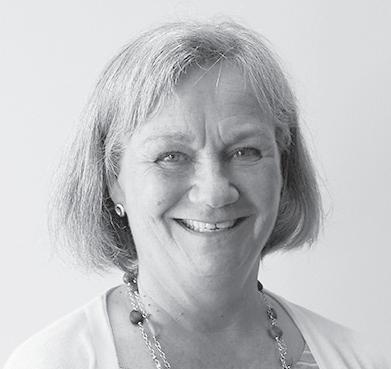
Some doughnuts he sugared and others he spread with a maple glaze topped with crumbled bacon. They were delicious and popular. He never made a huge batch, so they ended up selling fast. On Thursdays, people actually started to line up for them in our driveway! His favorite memory of that time was having three pre-teen girls come up to the table and ask him, “Are you the doughnut man?” He even sold one to the governor when she was visiting the island.
We only had the market for two summers and then life started trending toward normal and folks got back to their pre-COVID ways. Bruce made the doughnuts once last year, on Father’s Day, and passed them out to a bunch of his friends. I’m pretty sure he will make them again when the grandkids come to visit.
I smile when I think that Hildegarde and Emerson’s great nephew has helped to create some memories that only an island-made doughnut provides.
Barbara Fernald lives on Islesford (Little Cranberry Island). She may be contacted at Fernald244@gmail.com.
us and, while not usually reclusive, still somewhat solitary.
My friend talked of her involvement with one or two of those families and spoke generally to the circumstances in which they flourished while discreetly acknowledging the presence of two or three of those who were there in attendance.
The assemblies she described were not unlike those in which I participated; two or three, maybe four musicians, all string players, and a very appreciative audience of six to ten. Most arrived, often every day, as soon as their individual routines allowed, each assembling the drink of their choice from among the bountiful ingredients arranged on the workbench.
Conversation quickly ensues, bad jokes, old memories or maybe contemptuous commentary on what’s going on in the government, here or in the state or nation.
Meanwhile, guitars and banjos, maybe a fiddle, are being tuned and at some point, without regard for things mid-conversation elsewhere, the music begins, everyone settles in,

and quiet appreciation reigns. Perhaps it’s February, in which case we’re all around the wood stove.
For decades a men-only environment prevailed, not so much because women were not allowed but because it hadn’t occurred to anyone they might be interested or feel welcome and in many instances the latter was certainly true. Nowadays the more enlightened gatherings are of men and women, much to the benefit of all concerned.
Interspersed with my friend’s very personal tales were her own profoundly beautiful compositions. As I confessed earlier, I keep misjudging people. I apparently misjudge weather too. It was not a miserable day.
19 www.workingwaterfront.com may 2024
Phil Crossman lives on Vinalhaven. He may be contacted at PhilCrossman. VH@gmail.com.
Unhealthy progression: algae, bacteria, hypoxia
Last summer’s ‘brown water’ may be a frequent occurrence
BY JENNIFER SEAVEY
FISHERMEN LOVE their coffee, but they don’t want the ocean to look like it! Last summer, that is just what the ocean looked like across the Gulf of Maine, from Penobscot Bay to Martha’s Vineyard.
The brown water was the result of a massive bloom of microscopic algae (otherwise known as phytoplankton). As this bloom grew denser over the course of the summer, it reduced sunlight penetration in the water column which led to the dying of these sunlight-dependent algae, which in turn is gobbled up by bacteria.
This resulting bacteria bloom consumes oxygen in the water and gives off carbon dioxide which can, when blooms are big enough, induce dangerously low oxygen levels in the water, known as hypoxia.
Hypoxic waters can create dead zones, where die-offs of fish, shellfish, and aquatic plants can occur. In 1999, 75% of the lobster in Long Island Sound disappeared; a contributing factor was hypoxia. In recent years, Cape Cod lobstermen have seen dead and declining lobsters over time because of hypoxia and they certainly saw the negative impact of last summer’s bloom.
Just as concerns about hypoxic waters were mounting farther north, the seasonal changes and storms in the Gulf of Maine
reduced favorable growth conditions and the bloom subsided—for now. It is interesting to note that researchers are finding algae blooms increasingly hard to predict, with many surprise events, including the presence of non-native species.
But before you start hating phytoplankton, I must point out that it is, of course, not so simple. The abundant marine life in the Gulf of Maine is built on a foundation of critical seasonal (mostly spring, sometimes fall) phytoplankton blooms. However, as we all know—perhaps ponder your last holiday meal—there are times when we experience too much of a good thing.
Harmful algae blooms (HABs) are blooms of microscopic organisms in fresh or salt water that produce toxins and/or hypoxia-inducing dense blooms. While all HABs have the potential to induce hypoxia, toxic HABs are also notorious for shellfish poisoning, respiratory irritations in humans, and many negative health impacts for fish, marine mammals, and birds.
HABs are often induced by sunlight, salinity changes, warm water temperatures, ocean currents, and especially the input of nutrients running into the ocean during rainstorms. Climate change is increasing water temperature and causing more extreme rainfall events in Maine and thus, HABs are expected to increase over time.
reflections
The tools to combat algal blooms are pretty good right now, but as conditions that support blooms increase with climate change, we need to increase ocean monitoring and reduce nutrient pollution.
As these blooms are becoming more common, federal and state agencies, research organizations, and fishermen have joined together across the Gulf of Maine to track water conditions. This tracking can guide research and action from nutrient reduction to moving lobster traps.
A major monitoring effort is underway through the Integrated Ocean Observing System, a partnership among federal and state agencies, universities, and non-profit organizations which serves as the nation’s “eyes on the ocean.” The system operates a variety of ocean observation technology across the Gulf, provides realtime data on water conditions, tracking potential and occurring blooms.
Dr. Jake Kritzer and Jackie Motyka from the observing system’s northeast office stated last fall that while the identification and monitoring of last summer’s bloom was effective and showed the value of the system, it also illuminated some gaps, like offshore monitoring in the northern Gulf of Maine. With proper funding and expanded partnerships, this gap can be closed.
When high standards can stand in the way
Being a teacher doesn’t bring all the answers
BY KAYLIN WU
Reflections is written by Island Institute Fellows, recent college grads who do community service work on Maine islands and in coastal communities through the Island Institute, publisher of The Working Waterfront.
RECENTLY, I WROTE an incorrect answer to a question in front of a group of students. We were learning how to work with variable lists in Javascript and how the rules we established for variables still applied with variable lists. I placed an element in the wrong index and didn’t catch it until one of my students raised his hand and said my answer didn’t match his.
I brushed it off, made a joke about not reading carefully, and carried on with the lesson. Inside, I felt ashamed and incompetent. This had nothing to do with the student who corrected me. If anything, I was glad he understood the lesson well enough to catch my mistake. Nevertheless, self-doubt loomed over me, long after we’d moved on from the lesson.
When I began working at the Vinalhaven School as an Island Institute Fellow, I was a novice when it came to
the skills in my job description. My goal was to support technology opportunities at school, helping teachers use their technology effectively, and coaching a robotics team—not exactly skills I learned while studying English and studio art as an undergrad.
However, most of my jobs after college relied on teaching myself new skills, whether those skills were website design or database management. While I lacked immediate experience, I could compensate with my proclivity to learn from scratch.
Within my first year at school, it was clear that an in-person computer science class would help students and my role expanded to teaching, despite having no prior experience. I took the summer to learn as much as I could about teaching computer science, taking a class to familiarize myself with the curriculum.
The stakes are high in education. Teachers are not only trying to provide students with the knowledge they need to be successful, but they are also teaching habits and ways of thinking. Just as necessary as learning to read or do math are learning to problem solve, think critically, and find joy in

Nutrients, especially nitrogen and phosphorus, originating from landbased human activities gets washed by rainstorms into rivers, lakes, and the ocean triggering and feeding algae blooms (and increasing ocean acidification). Cleaning up waste, reducing storm run-off from streets, yards, wood processing, and agricultural lands can significantly reduce the potential of algae blooms. Maine’s best management practices for regulating run-off is identified in the Maine Climate Action plan for updating and improvements.
Finally, certain marine ecosystems like oyster beds and eelgrass naturally filter nutrients out of the water. Restoring and promoting natural systems is a win-win for a healthy Gulf of Maine to support us, our economy, and nature itself.
Jennifer Seavey is chief programs officer with Island Institute, publisher of The Working Waterfront. She oversees strategy and supports work in climate resilience, the marine economy, and sustainable community development. She may be contacted at jseavey@ islandinstitute.org.
learning. While there is great privilege in being a part of this process, there is also the fear that students may not come away with something meaningful.
When I don’t know the answer in front of my students, my fear is that it says something about who I am as a teacher. Why am I trusted to teach this class? Do my students think of me as an effective teacher? Do I even believe I’m capable of this?
Not too long ago, my fiancé and I got into a disagreement over repairing our duck coop. The door to the coop fell off during a storm and I wanted to fix the door so it wouldn’t fall off again. My plan was to reset the door frame, attach stronger hinges, and add wood reinforcements to parts of the door.
But we were still in the midst of winter and the weather meant the door would continue to warp with the thawing and refreezing, along with the ground shifting. My fiancé thought it might work best if we just reattached the door so the ducks would be safe until winter’s end.
Despite how unrealistic my plan was, I was frustrated and restless knowing the door wasn’t exactly the way I wanted it to be.

I approached teaching like I approached the coop door. I wanted my teaching to be the best it could possibly be before standing in front of students. The fact of the matter is I was never going to be a perfect teacher after one summer. I could pour myself into studying, practicing, and planning to be as prepared as possible; however, it’s impossible to expect I’d achieve a level of teaching that takes a career to be great at.
Perhaps the best I could do was try my hardest, dedicate myself to lifelong learning, and be courageous enough to not know the answer.
In a few weeks, once the ground thaws more, my fiancé and I are planning to repair the coop door to my liking. Until then, I’m grateful my ducks are safe.
Kaylin Wu works with the Vinalhaven school on technology integration from pre-K through 12th grade and fosters a growing Lego robotics club and other technology centered after-school experiences.
20 The Working Waterfront may 2024
fathoming
The Jacob Pike, a victim of January’s storms
The boat was launched at the peak of herring harvests
BY KEVIN JOHNSON
IT WAS APRIL 28, 1949, when the 83-foot sardine carrier Jacob Pike was launched with some fanfare in Thomaston. Built by Newbert & Wallace for the Holmes Packing Company, she was the third sardine carrier launched from Midcoast boatyards that year.
The launch of a new boat was always a time of celebration. To the new owners it was the excitement and hope of prosperity and return on their investment, and, to the builders, it was the satisfaction of another completed job of turning a designer’s vision into a reality.
It’s no surprise that each launch was documented by photographers eager to supply the various fishing and boating publications as well as an opportunity to sell prints to the new owners.
Sardines, also known as herring, were big business in Maine in the post-war economy. In 1950, there were 46 active canneries employing more than 10,000 people. It was in 1950 that Maine recorded its largest domestic landing of 90,557 metric tons of herring before beginning a steady decline.
The industry needed the specialized sardine carriers to transport the fish caught in weirs or seine nets back to the factories, and scores were built. The Jacob Pike outlasted most of them.
The Pike was named after the father of Moses Pike, part of the Pike family fishing dynasty of Downeast Maine. She was one of the first carriers to offer refrigerated storage and a

modern electrical system that made her state-of-the art.
She was nearly identical to her sister ship the Mary Anne which had been launched the year before and was capable of storing 1,470 bushels of herring.
After the fall of the sardine industry she was used to carry fish and lobster bait. In 2007, she was purchased by the Penobscot Marine Museum which had hopes of turning her into a floating museum but could not secure the funding needed so she went back to work for a few more years.
The photos of the Pike’s launch day, included here, were taken by Jim Moore of Rockport. Moore was the Midcoast correspondent for the Portland Press Herald and worked freelance for other publications, like the Atlantic Fisherman that initially published these photos.
Community building
To the Editor:
Thank you for Kim Hamilton’s terrific “From the Sea Up” column in the April issue of The Working Waterfront (“The storm damage we cannot see”). After so much discussion along the coast about the physical aspects of restoration, it was so important to see your community building emphasis. We are on the outer shore of Cliff Island and got hammered very hard. Not severe damage to buildings, since the ones we have along the shore are modest, but just a massive attack on soil and vegetation, and pretty dramatic remaking of the beach and ledge land between us and the water.
Also, what I truly estimate as many tons of loose rock of all sizes are now up against buildings and on what used to be lawn. The column’s point about community building holds true— for us, made manifest in three different branches of our family coming together around the property in a way that hasn’t happened in many years.
Island wide, there was some loss of fishing docks, fish houses, wharves,

Ironically, these photos of the Jacob Pike’s “birth” reappeared at what seems to be the time of her final demise. She currently lies on the bottom of the New Meadows River off Harpswell, a victim of one of the big January storms as she was waiting to be repaired by a new owner.
After a few months underwater it seems unlikely that she can be saved, though it’s not deterring Sumner Rugh, the great-grandson of her namesake, from trying.
Now a navigational hazard and leaking oil, it’s a sad end for such a noble vessel.
In 2022, The Penobscot Marine Museum acquired a collection of
He was also friends with fellow photographers Kosti Ruohomaa and Carroll Thayer Berry, with whom he published Maine Coastal Portrait in 1959. He died in 2001.
letters to the editor
land, and road access for some houses on the easternmost bluff— all blows to our small community. We are glad to have Island Institute working for all the coastal communities and especially glad to have a Chebeaguer at the helm!
Marcia Sharp Yarmouth and Cliff Island
Important work
To the Editor:
I just read Kim Hamilton’s “From the Sea Up” column in the April issue of The Working Waterfront, “The storm damage we cannot see.” It was excellent. As a psychiatrist, I’m so glad you’re noting the psychological impact of these terrible coastal storms and encouraging folks to reach out to their neighbors in need and make community connections. It is so important. Thank you for the work you’re doing at Island Institute.
Julie Leavitt San Francisco, Calif.
Delightful
To the editor:
Thank you for publishing Patricia Estabrook’s article about Newfoundland in the April issue of The Working Waterfront. It was a delightful and beautifully written piece that reminded me of just how unique this place is. Inspired by Patrica’s description, I listened to a YouTube version of “Sonny’s Dream,” a powerful song with notes of sad loneliness combined with a deep longing.
My wife and I visited Newfoundland two years ago and we thoroughly enjoyed what we saw and heard and learned there. Alas, we didn’t have time to go to St. John’s, and having read Patricia’s article, it makes me want to return to Newfoundland and see that part of the island.
Thanks again.
Rick Davis Belfast
several thousand of Jim Moore’s maritime-related negatives, and an exhibit drawing from it will be on display at the Camden Public Library during the month of April. “Jim Moore—Midcoast Correspondent” will be on display in the Picker Room of the Camden Public Library, April 2-30. Captions for the exhibit were written by maritime historian Maynard Bray.
The museum’s new exhibit, Powering Up: The Evolution of the Maine Lobsterboat, opens May 23.
Kevin Johnson is the photo archivist at the Penobscot Marine Museum in Searsport. See PenobscotMarineMuseum.org for more information about exhibits and collections.
Stunning
To the editor:
I am grateful to Patricia Estabrook for her wonderful article about Newfoundland in the April issue of The Working Waterfront.
The natural beauty and expanse of the province is stunning, but understanding the history and sociology of the place was what grabbed me. I definitely plan to check it out this summer and wouldn’t it be nice if Maine could get some ideas from how they’ve handled economic challenges?
Betsey Remage-Healey Peaks Island
The Working Waterfront welcomes letters to the editor, which should be sent to Tom Groening at tgroening@ islandinstitute.org with “LTE” in the subject line. Longer opinion pieces are also considered but should first be cleared with the editor.
21 www.workingwaterfront.com may 2024 in plain sight
The Jacob Pike underway. PHOTO: PENOBSCOT MARINE MUSEUM
Launch day of the Jacob Pike at the Newbert and Wallace yard in Thomaston on April 28, 1949.
From left: Lawrence Lord, engineer; Alfred Lord, mate; and Capt. Sherman Lord.
art of the waterfront
Emily Muir and the seiners
Stonington painter honored fishers of the sea
BY CARL LITTLE
IN EMILY MUIR’S watercolor “Flaking the Purse Seine,” painted around 1940, four fishermen in caps lean into their work, gathering the nets in preparation for taking to the sea.
“In the days when nets were made from natural fibers,” Ben Fuller, maritime historian notes, “you needed to clean and dry them after use,” adding that they often were submerged in vats of salt preservative to keep them from rotting.
Muir renders the fine-mesh nets in a gray wash that is a shade lighter than the ledge in the foreground. Lines of cork floats snake around the scene. Three boats, one of them named E. King, are pulled up on the shore. There’s a clutch of what are probably glass buoys and an almost comical line of white gulls looking on at the laboring men.
When Muir (1904-2003) and her husband, sculptor William Muir (1902-1964) moved to Stonington in 1939, the town had an active sardine cannery. They were both taken by the working harbor with its fishermen and the stonecutters who worked in the island quarries and they honored them in their art. Emily’s stone mosaic, “Stonington,” is one of the stars of the Farnsworth Art Museum collection while William’s bronze “Stonecutter” is a landmark on the town’s waterfront.
In her 99 years Emily Muir lived a kind of ultimate modern American life span that included five wars,
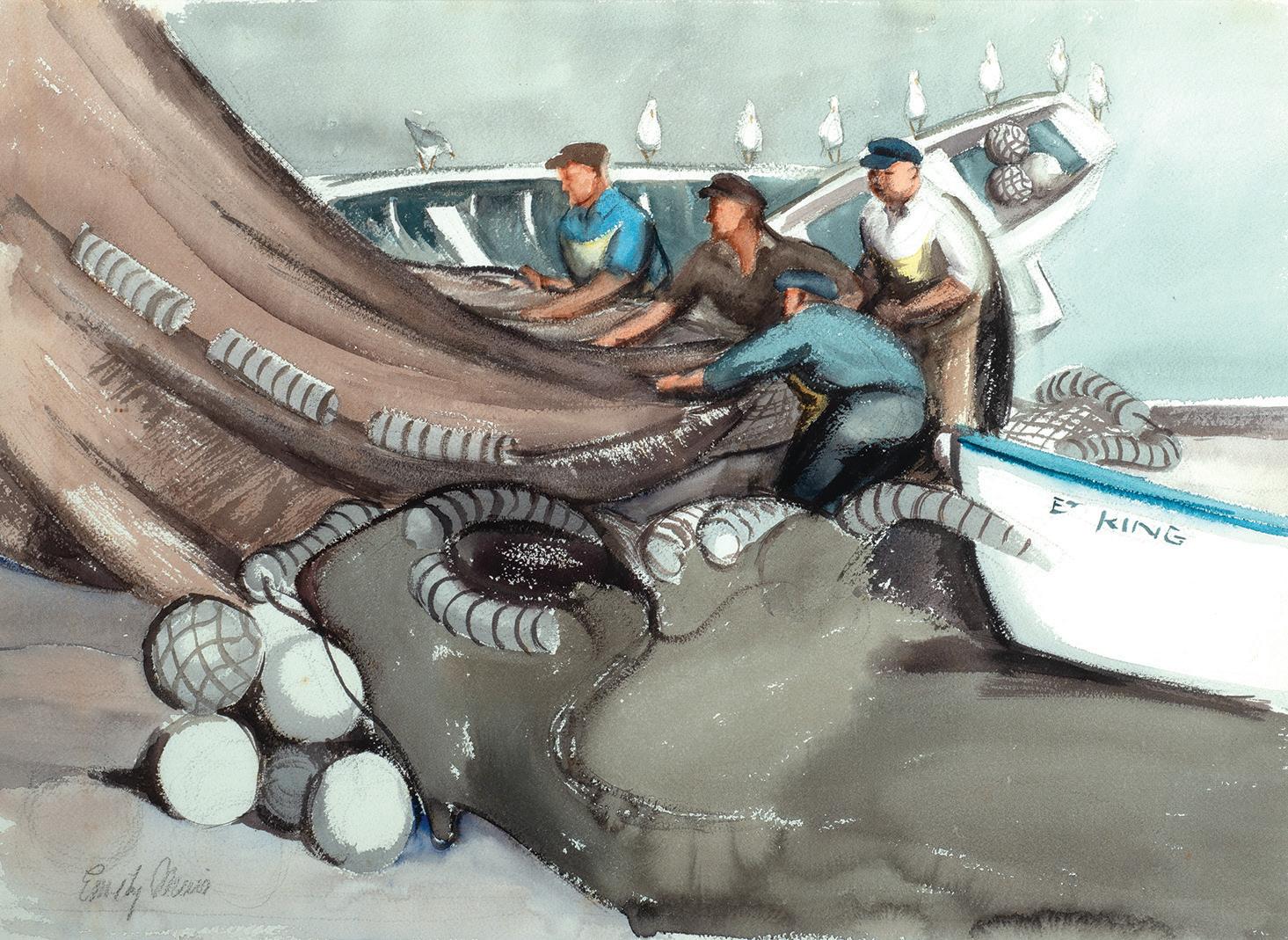





22 The Working Waterfront may 2024
JB Paint Company INDUSTRIAL MARINE COATINGS & SUPPLY Epoxy & Urethane Coatings Blast Media & Supplies, Sprayers, Sprayer Repair/Supplies....and more.... 2225 Odlin Road, Hermon ME 04401 207-942-2003
GET H A ULIN’ Jonesboro, ME (207) 434-5791 Portland, ME (800) 244-8727 Thomaston, ME (800) 426-4526 West Bath, ME (855) 848-6027 BROOKSTRAPMILL.COM Enter to win a $100 gift certificate by visiting our website or “Like” us on Facebook. BROOKS TRAP MILL & MARINE SUPPLIES A large selection of traps and trap kits Stop by for all your fishing and commercial boating needs CHASLE21.PLT 2/10/2021 2:43:50 PM PORTLAND 207-772-6383 ELLSWORTH 207-667-9390 NEW LOCATION IN PORTLAND: 84 COVE STREET MARINE SAFETY CONSULTING LIFE RAFT INSPECTIONS Life Raft Sales and Inspections Inflatable Boats • Charts Books • Navigational Tools Linkel Construction, Inc. Locally owned and operated; in business for over twenty-five years. • Specializing in slope stabilization and seawalls. • Department of Environmental Protection (DEP) certified. • Experienced, insured and bondable. Free site evaluation and estimate. • One of the most important investments you will make to your shorefront property. • We have the skills and equipment to handle your largest, most challenging project. For more information: www.linkelconstruction.com 207.725.1438
“Flaking the Purse Seine,” circa 1940, by Emily Muir (1904-2003), watercolor on paper, 16 1/2 x 23 inches.
PHOTO: COURTESY OF BARRIDOFF AUCTIONS
the Great Depression, and 9/11. Her autobiography, The Time of My Life, published by the Island Institute in 2002, takes the reader from her birth in Chicago through early years in New York City; a short stint at Vassar (she was asked to leave after wearing men’s knickers and shoes to a friend’s graduation ceremony); meeting her husband at the Art Students League (her classmates included Ludwig Bemelmans of the Madeleine children’s books fame and Isamu Noguchi, who become one of the most important sculptors of the 20th century); working at Macy’s department store; travels and adventures abroad, including trips to the West Indies, South America, Russia, and Scandinavia; and her life in Maine.
Muir’s history includes her husband’s stint in the Navy during World War II. Enlisting at age 40, he started off in Portsmouth, N.H., then went to the Brunswick Naval Air Station and finally to Mare Island Naval Shipyard in Vallejo, Calif., where he worked in a hospital for amputees and victims of shell shock.
Emily’s parents were so impressed with his enlisting they gave him Russ Island, part of the archipelago that lies between Stonington and Isle au Haut (the Chewonki Foundation became the “proud owner” of the island in 2006).
After hosting Margaret Chase Smith at her parents’ home in Stonington, Muir was asked to paint the senator’s official portrait (when the Maine Arts Commission asked for 23 changes, the artist responded, “Go do it yourself”). As a result of that commission, she was appointed to the Commission of Fine Arts under Eisenhower and then Nixon; it later became the NEA. The only woman on the commission, she was pretty much ignored. At one point she suggested that a certain percentage of the cost of any new government buildings be reserved to enrich and beautify them. Her suggestion fell on deaf ears but she liked to think it may have somehow

inspired the percent for art program, which has been so successful in Maine.
The Muirs were responsible for finding land for the Haystack Mountain School of Crafts when it decided to move from Liberty in 1960. The building of the Deer Isle bridge in 1939, of which Emily didn’t really approve, helped in the decision to move the school.
In addition to being a painter, Muir was a self-taught architect and designer, as well as an author, lecturer, and conservationist. Island Institute founder Philip Conkling referred to her as a “practical visionary,” protecting islands from development. The Muirs’ papers are in the Smithsonian Archives of American Art, donated by Emily in 1993 and 1996.


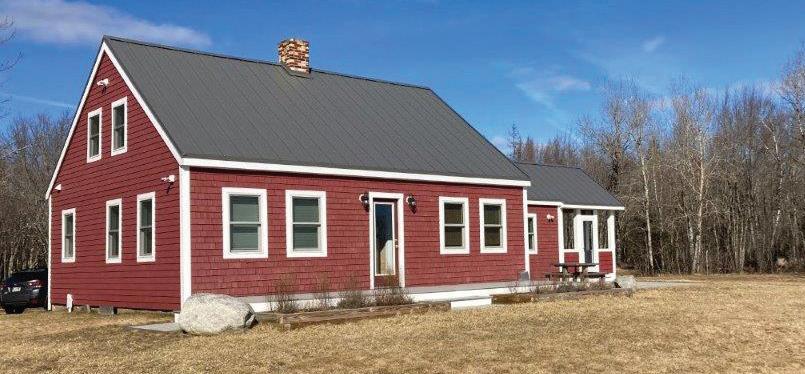
meticulously restored with a beautiful interior to include 4 bedrooms, 2 on the first floor and 2 on the second, center chimney with the original wood-burning fireplace in the living room, beautifully appointed kitchen opening onto a screened porch. Completely turn-key with lovely furnishings and 2 beautiful full bathrooms. The barn is reverse living with a ground level with a summer kitchen, huge screened porch on the water side for large lobster feeds when friends gather, the living room, kitchen, 2 bedrooms and 2 baths on the second floor open to the peak with the gorgeous post and beam frame exposed. A screened porch opens from the living room on the second floor looking across the field to the bay. Third floor has a bunk room with a ships ladder to a tower with 360 views to the harbor, village and open ocean. This is a property not to be missed with everything on your wish list when you are ready to move to Maine. Both houses, turn-key ready. $1,775,000.

Muir was a founding member of the Island Institute and worked with the institute, the Nature Conservancy, Maine Coast Heritage Trust, and the Stonington Conservation Commission, among other environmental organizations, to preserve land in Maine.
She and her husband were also great community people. Among other things, they invited local kids to come and swim in a saltwater pool they constructed on the shore near their house. Some of them learned to swim for the first time.
Courthouse Gallery Fine Art in Ellsworth represents Emily Muir’s estate. Carl Little provided the introduction to The Prints of Siri Beckman (Down East Books).








23 www.workingwaterfront.com may 2024
Headquarters: 888 Boylston Street Suite 520 | Boston, MA 02199 Maine Offices: Camden: 23 Main Street | 207-236-3543 Northeast Harbor: 125 Main Street | 207-276-3840 Portland: 36 Danforth Street | 207-774-8518 If you are Buying We offer spectacular properties for sale throughout New England and beyond If you are Selling We understand Maine’s waterfront and can help you achieve your property’s best value whether it’s a marina, boatyard, land or luxury estate If you need Consulting We provide land planning, appraisal, and project management for significant real estate assets If you invest in Timberland We lead the nation in the marketing and sale of investment timberland properties We’ve traveled the back roads, we’ve navigated the waters, and we know Maine. www.landvest.com SCAN TO EXPLORE TACY RIDLON (207) 266-7551 TACYRIDLON@MASIELLO.COM On 16 acres of open fields with long views down the bay to open ocean, this perfect marriage of
1850’s
and 4,000 square ft. barn house
for one unusual property. With 700 feet on the bay, the shoreline lends itself to kayaking or just sitting and watching the tides come and go.
an
cape
makes
The cape has been
William and Emily Muir, ca. 1943. PHOTO: COURTESY COURTHOUSE GALLERY FINE ART
We get it, Commercial Lobstering and Fishing means a lot to our seaside towns and cities. That’s why we’re all about bringing you everything from time tested equipment and gear to the newest in technology to outfit your boat and crew. We want to help you keep on keepin’ on, no matter the season.




























800-639-2715

1. noun: springtime; the season of spring
2. noun: a swelling or rush of anything; “he rose to the springtide of prosperity”
3. noun: a greater than average tide occurring during the new and full moons
4. noun: the monthly giving program at Island Institute

Our recurring donors never miss an issue of The Working Waterfront or the annual Island Journal. Monthly giving adds up, for greater impact in island and coastal communities, and ensures that your membership does not lapse. Springtide membership is also easier on the environment; all transactions and confirmations are online. No paper! Less mail!
24 The Working Waterfront may 2024
SPRINGTIDE
more
For
information about Springtide monthly giving, please email membership@islandinstitute.org Join the Springtide Society today with a few easy clicks for as little as $10 per month
GIVING.ISLANDINSTITUTE.ORG Nobody finances commercial fishing like Farm Credit East. Like agriculture, the fishing industry has its own unique credit needs. And we’re proud to serve them both. No other lender offers more expertise, specialized financial products, or dedicated services to achieve your goals. farmcrediteast.com | 800.831.4230 Financing For: Boats & Trucks Real Estate Permits Bait Storage Facilities Wharves Equipment Haul Out & Repair Operating Lines OUR BUSINESS IS TO LEND YOU MONEY. OUR MISSION IS TO GROW YOUR SUCCESS. 11530_FISHING_Made in Ag_Our Business_4.9x7.35.indd 1 10/8/19 1:03 PM KITTERY • PORTLAND • ROCKLAND SEARSPORT • SW HARBOR • JONESPORT hamiltonmarine.com
Get Your Boat... Work Ready! WONDER GRIP LATEX DOUBLE COATED GLOVES Size Order# Small 762671 Medium 762672 Large 762673 X-Large 762674 2X-Large 778661 Scan QR Code for current pricing. MAINE’S Largest DISCOUNT MARINE STORE! SIX Locations in Maine!
in-store, by phone or online today!
Shop






















































































































